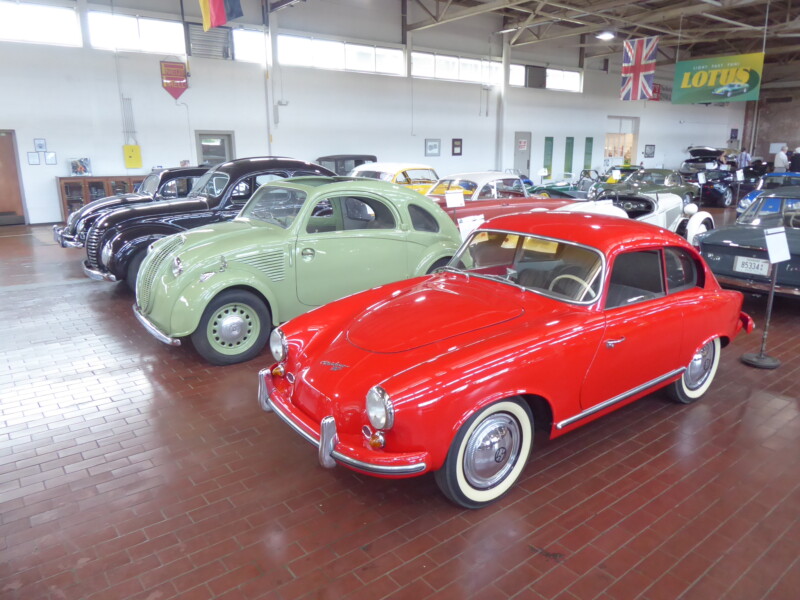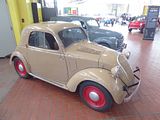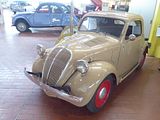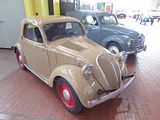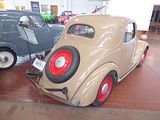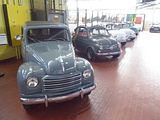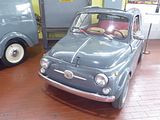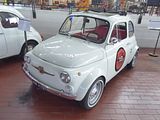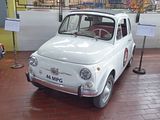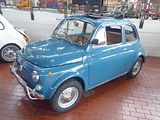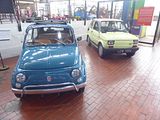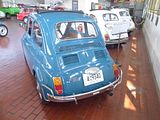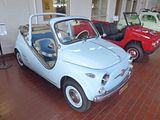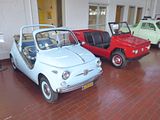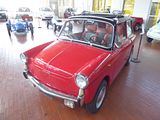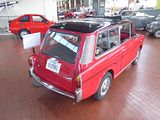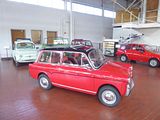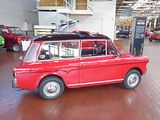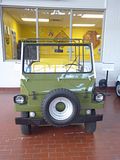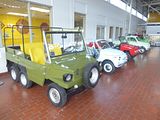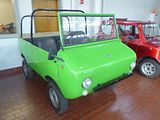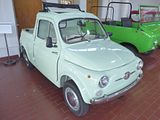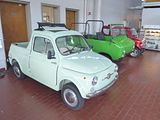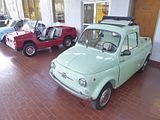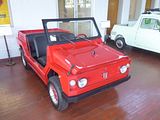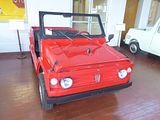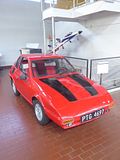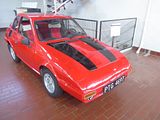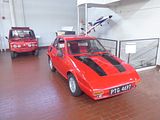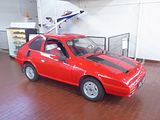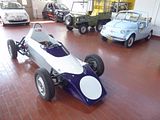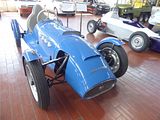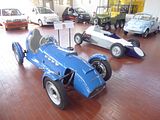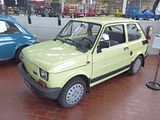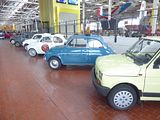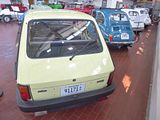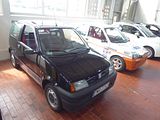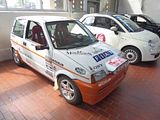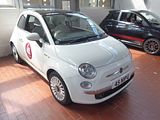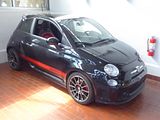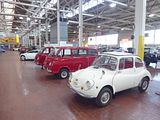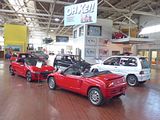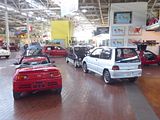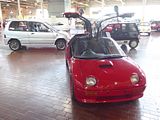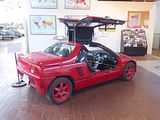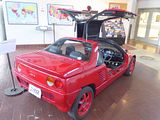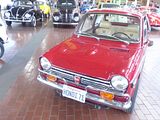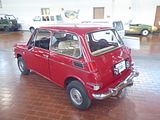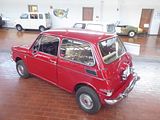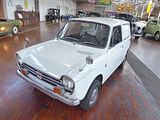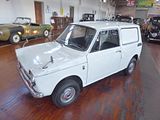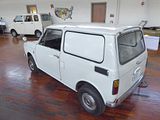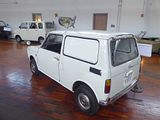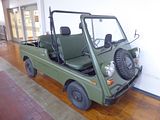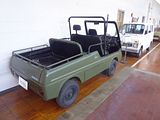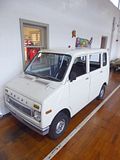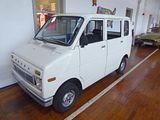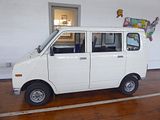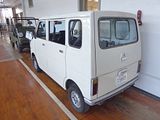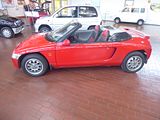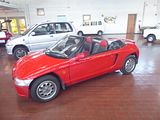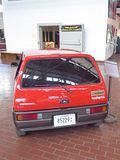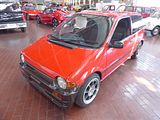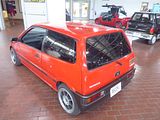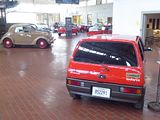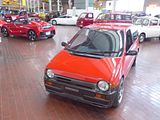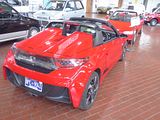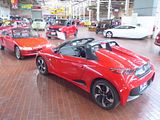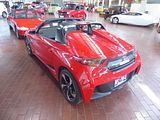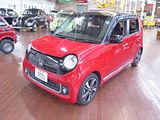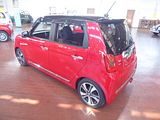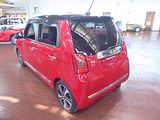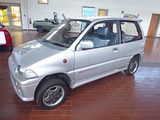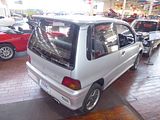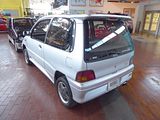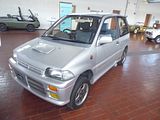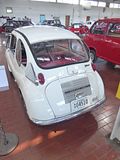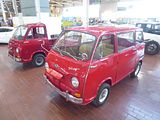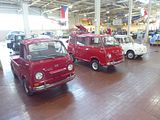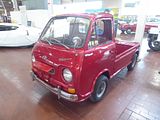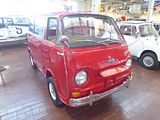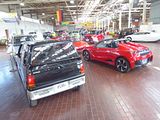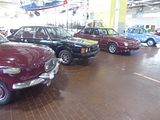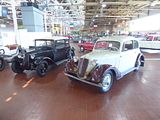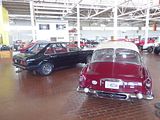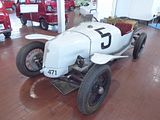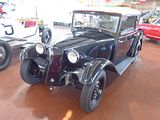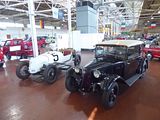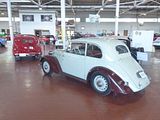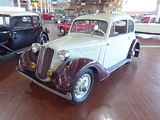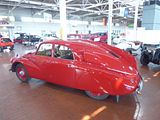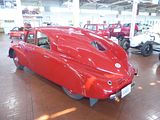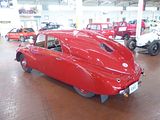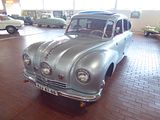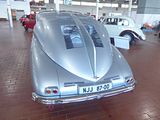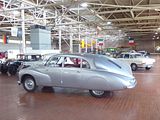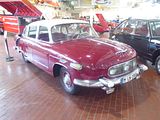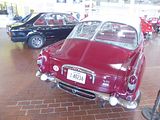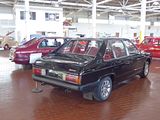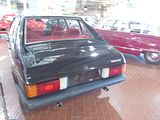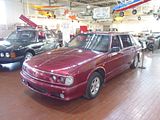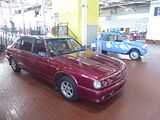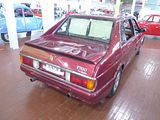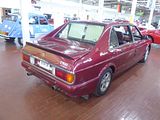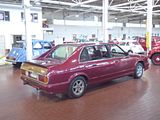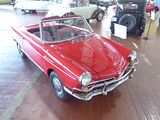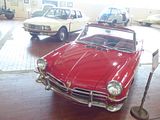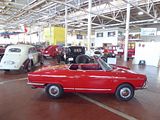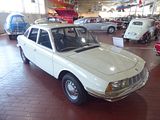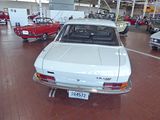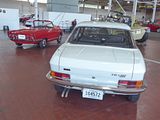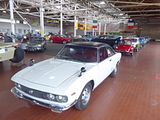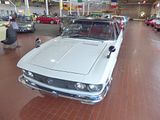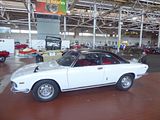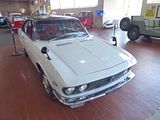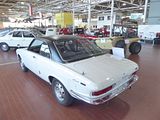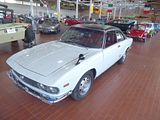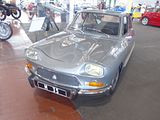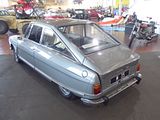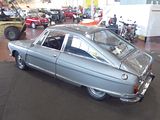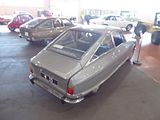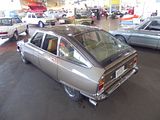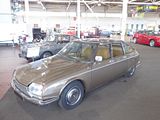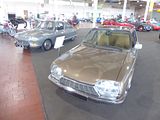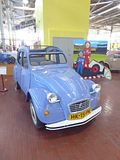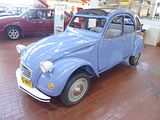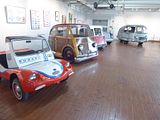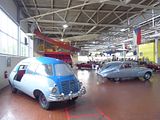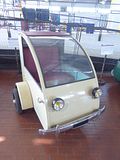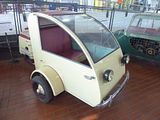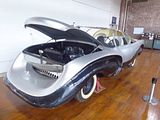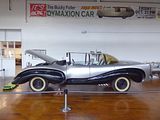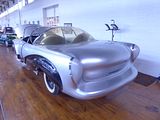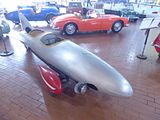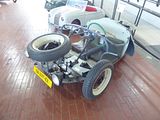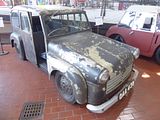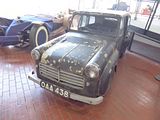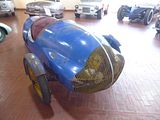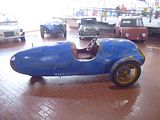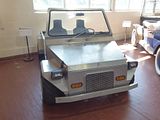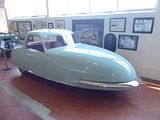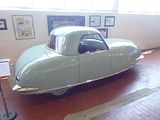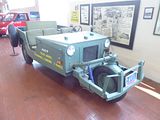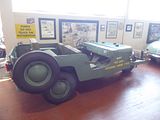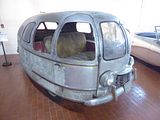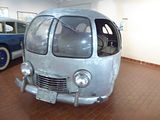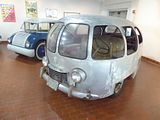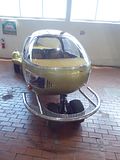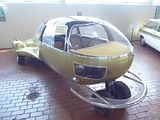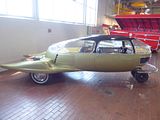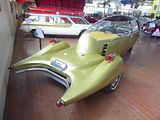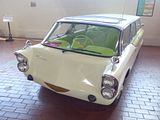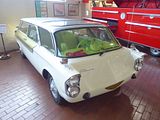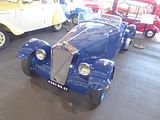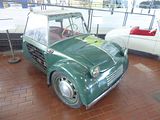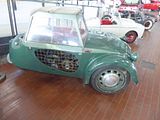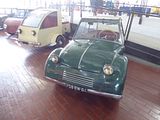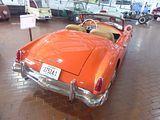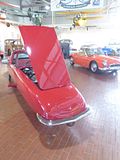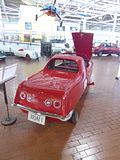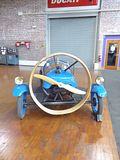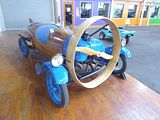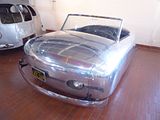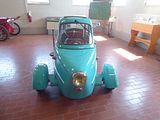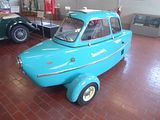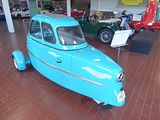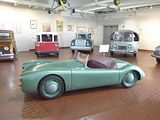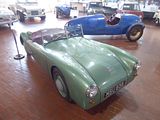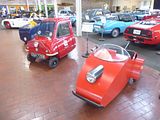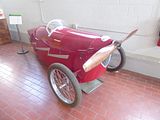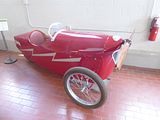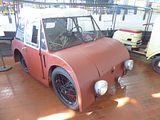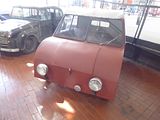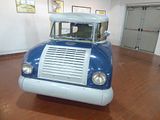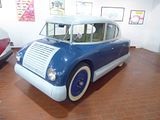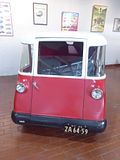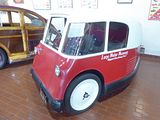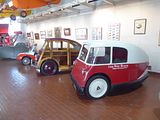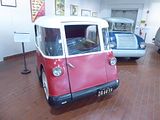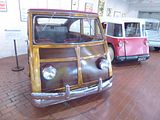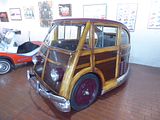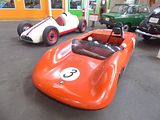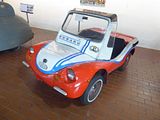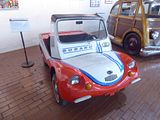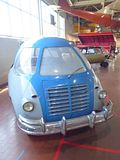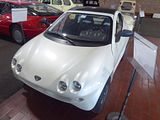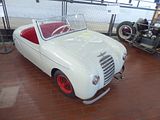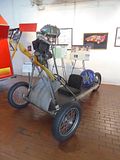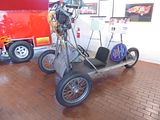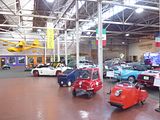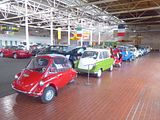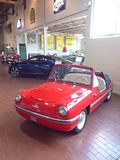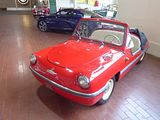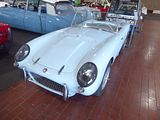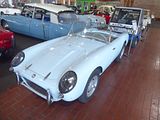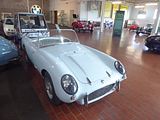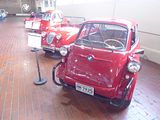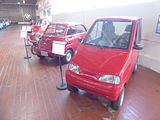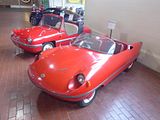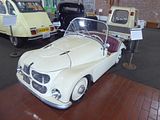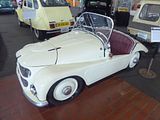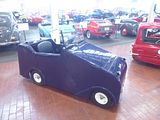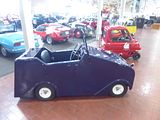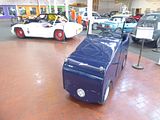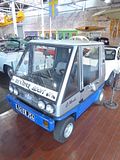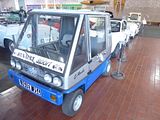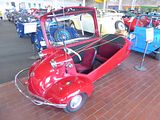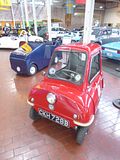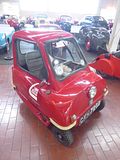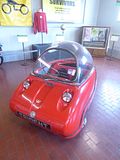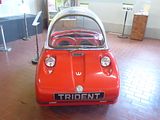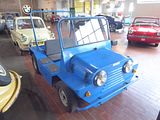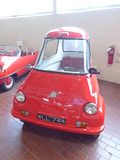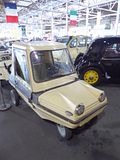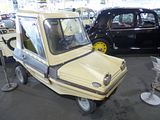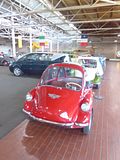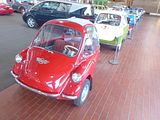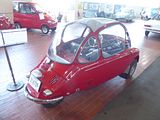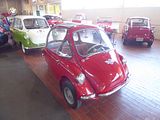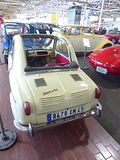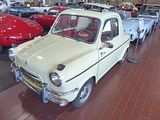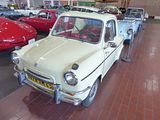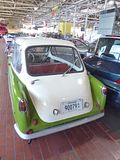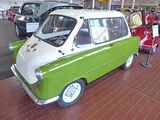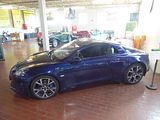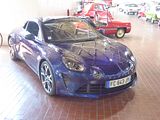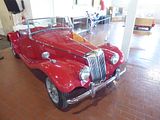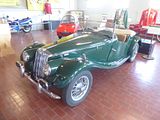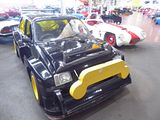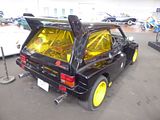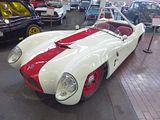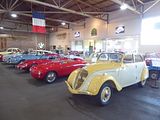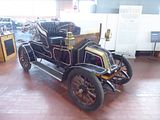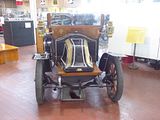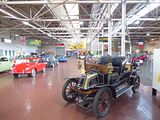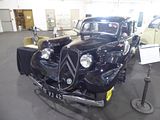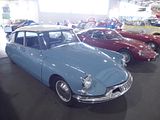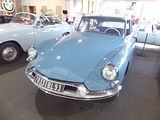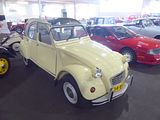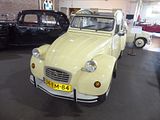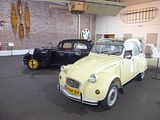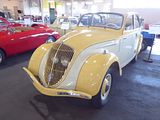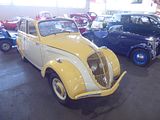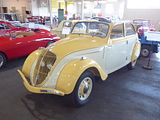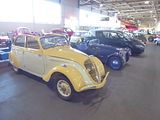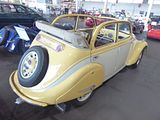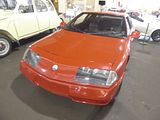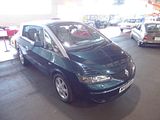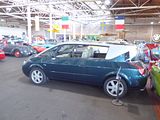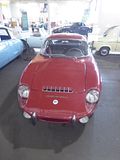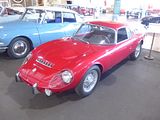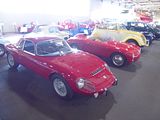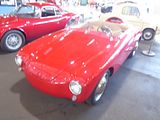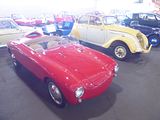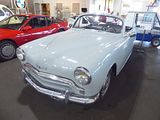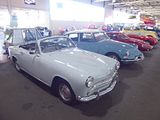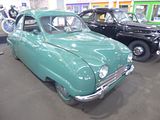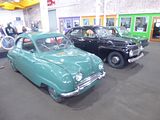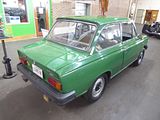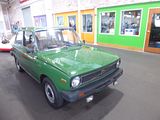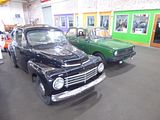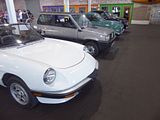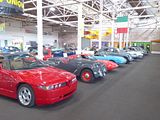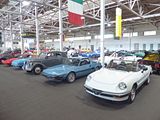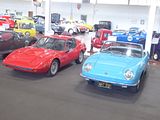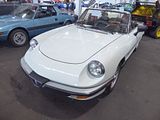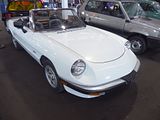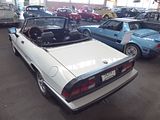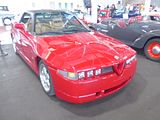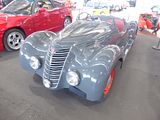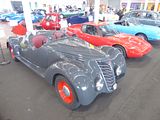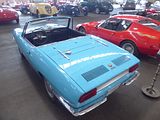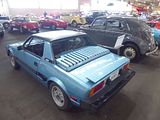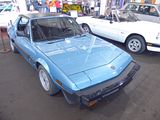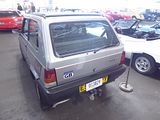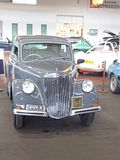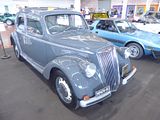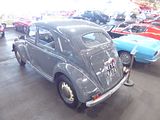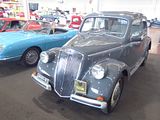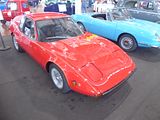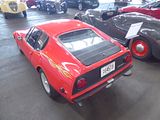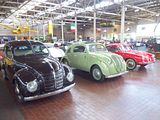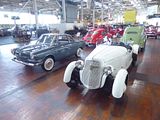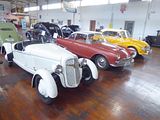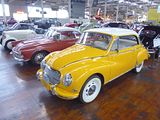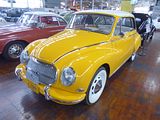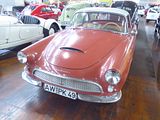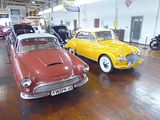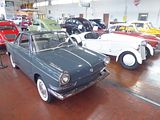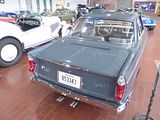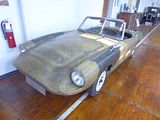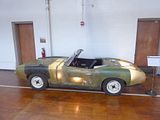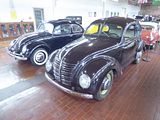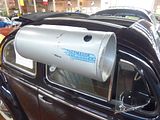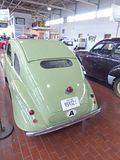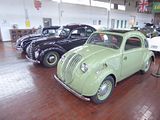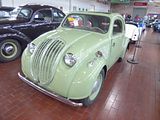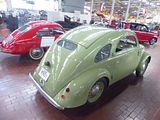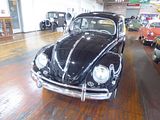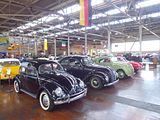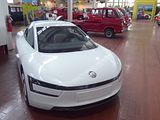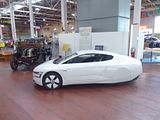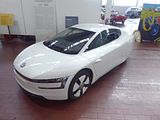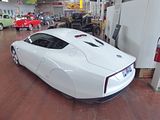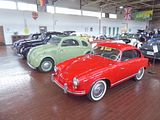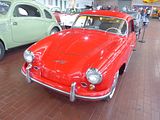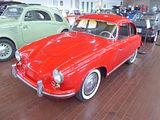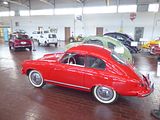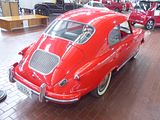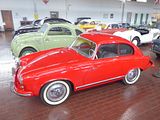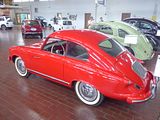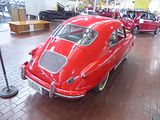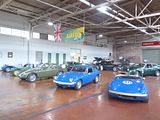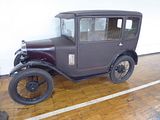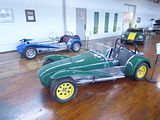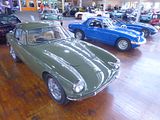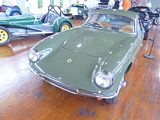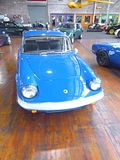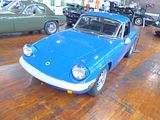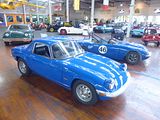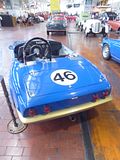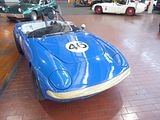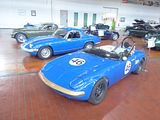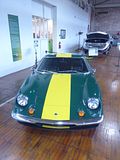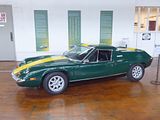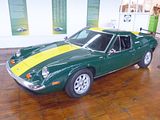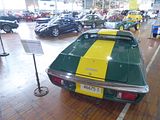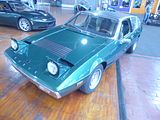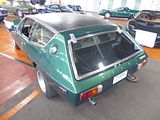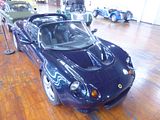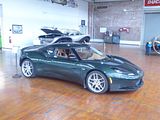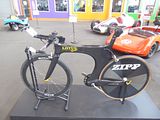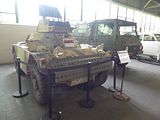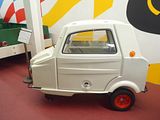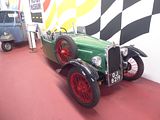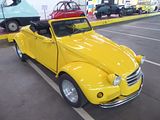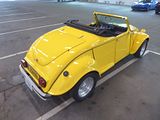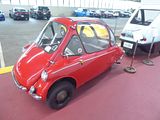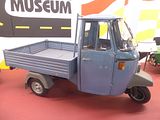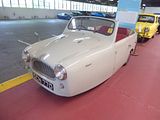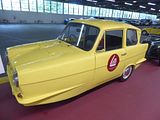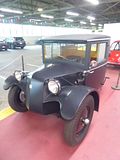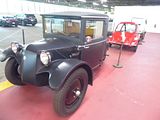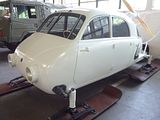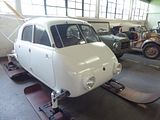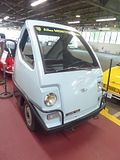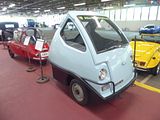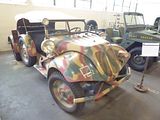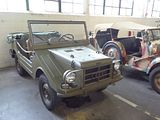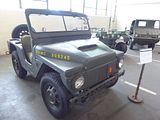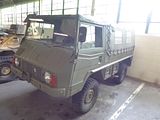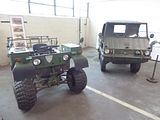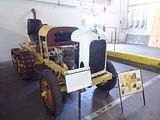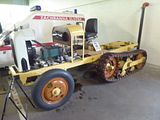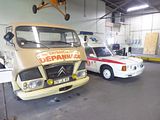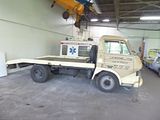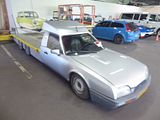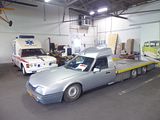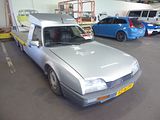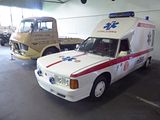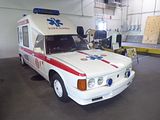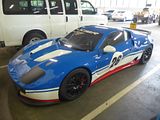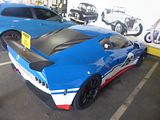Unlike the Coker Museum, in Chattanooga, which I came across purely by accident when in the town, I knew a lot about the Lane Motor Museum, and indeed everything I have seen over the years made me particularly keen to come and visit, so making sure I could do so was a key tenet when planning my first trip to some of America’s Southern States. The museum was established in October 2002 by Jeff and Susan Lane, beginning with his personal collection of 70 vehicles and is located in Nashville’s former American Bread Company (1951-1994). The collection currently includes art, memorabilia and over 500 vehicles, which is rather more than can be displayed at any one time. About 150 cars are on show on any given day, and I understand that the museum often divides the display up into a number of themed displays, and that was certainly the case when I visited, as you will see from this report. There are lots of surprises here, as the museum’s collection features European cars of unusual design, propeller-driven vehicles, microcars, three-wheeled cars, amphibious vehicles, alternative fuel vehicles, military vehicles, competition cars, one-off vehicles, prototypes — and 23 Tatras. Many of the cars that you do recognise are ones you would not expect to see in America, as they were never sold new on the US market, and a lot of what is on show is just so rare or bizarre that you, like me, probably won’t even know what you are looking at. There is lots of natural light in the museum building, and most of the cars are displayed with no ropes and barriers around them, so you can have a good look from all angles, and this does help the photographer, too. I spent more than two hours wandering around, enthralled at this collection. Here is what I saw, grouped into the various themes and special displays that were on show in early May 2023.
FIAT 500 and CLOSE RELATIVES
1936 Fiat 500 “Topolino”: Fiat began in 1899 when the Societa Aninima Fabbrica Italiana di Automobili – Torino was formed and has been building cars for over 100 years. Many consider the most famous Fiat to be the 500 “Topolino” (topolino translates to “little mouse”, a term of endearment the Italian people gave the small 500A). Launched in 1936, the new “baby” Fiat was the smallest mass-produced car of its time. With two seats, a 13bhp 569cc engine and a 6½ foot wheelbase, it was designed to bring motoring to the masses. It was a great success, and the initial version remained in production until 1948, with over 122,000 being produced. Although the Fiat 500 body style has changed over the years, Fiat produced a “Fiat 500″ well into the 1990s.
1953 Fiat 500C Van: In 1936 Fiat introduced the 500, or “Topolino” as a small car for the masses of Italy. Inexpensive and robust, the Fiat 500 sold in large numbers. The first version of the 500 was called the A model, and was produced from 1936-1948. The next model, B, was produced 1948-1949, and the final version, C, was produced 1949-1955. While the “A” model was only produced as a passenger car, but the “B” model also had a station wagon version, the Giardiniera-Belvedere. The car seen here is a “C” model, and it is basically a station wagon model without windows. Used by many small companies for deliveries, the van’s survival rate is very low as most of the vehicles were simply used up. Although the A and B models of the 500 were similar, the C had completely different front bodywork, and was the first Fiat to offer a heater-defroster. The engine was given an aluminium head, but output remained the same as the “B” at 16.5hp.
1964 Fiat “Nuova” 500D: Introduced on July 4th, 1957, the successor for the Topolino, the “Nuova (which means “New”) 500″ used a layout similar to that seen on the 600 with a rear mounted engine driving the rear wheels and independent suspension on all four wheels. A first for Fiat was the air-cooled engine, a two cylinder, 479cc unit with 13 HP, coupled to a four speed manual gearbox with a floor mounted shift. The woefully underpowered 479cc version of the Nuova 500 lasted only a single year, replaced by more powerful models in 1958. While the success of the Nuova 500 was not what Fiat expected, production of all types and variants of the Fiat Nuova 500 exceeded three million. The D series was produced from 1960-64 with 640,520 being made. The engine size had been increased to 499cc, and a few other changes, such as a revised gas tank, were also made.
1966 Fiat 500F: Production of the 500F began in 1965 the main changes from the 500D being the adoption of front-hinged doors and a revised transmission. The Fiat 500F was produced from 1965-72 with 2,272,092 of these models being made.
Fiat Abarth 695SS: Carlo (Karl) Abarth selected the scorpion emblem to represent his high-performing, powerfully tuned, sports cars. Abarth vehicles were small and agile, dangerously fast and did exceptionally well in competitive racing. He also developed sports car tuning kits in collaboration with Fiat that offered affordability, enjoyment, and broadened his patronage. The Fiat Abarth 695 “esse esse” (SS) was the top of that scorpion-brand. After a career racing motorcycles, Carlo Abarth founded Abarth & Co SpA with Guido Scagliarini in 1949. The Cisitalia-Abarth 204A sports car was one of the first vehicles they produced, known to be an impressive racetrack performer. Due to the economic demands of racing, Abarth began focusing his attention on mechanical components that added power to mass-produced cars—mainly Fiats. Abarth tuning kits included exhausts, manifolds, valves, and steering-column mounted gear levers among others. In 1958, Abarth signed an agreement with Fiat to take semi-completed car bodies for preparing with his custom components. One of the first vehicles was the Fiat Abarth 595, introduced in 1963, based on the Fiat 500 D. With a larger, 595cc capacity engine, new Solex C28 PBJ carburettor, and tuned fuel system, power increased from 18 hp to 27 hp. The very top of the series was the 695 SS version, introduced in 1966. The 695 SS was offered with a 38 hp engine that, with a little extra tuning, could be raised to over 50 hp. The 695 SS came equipped with special cylinder castings, stronger valve springs, and revised camshaft, allowing for higher engine speeds. The 695 SS was the only version to feature flared arches, and the need to raise the engine cover for extra stability and cooling. Only 1,000 Fiat Abarth 695 SS’s were ever produced and only 150 are believed to remain.
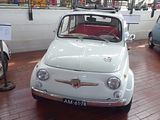
1969 Fiat 500L: Unmistakably, the Fiat 500, or Cinquecento in Italian, is linked with Italy’s culture. Derived from the original Fiat 500 Topolino, meaning little mouse, the 500 was produced to be an affordable, small car for everyone. The Lusso came out in September 1968 with a higher trim package than the standard 500 F. It featured tubular chrome bumper overriders at the front and rear and rectangular tail lights. The interior included a revised dashboard layout with a black steering wheel, and ribbed vinyl seats and door panels. Other changes comprised reclining seats and carpeting, and for the first time, the rear name badge spelled FIAT in uppercase lettering. The 500 was an incredibly popular little car and homegrown modifications were rampant. Coachbuilders and engine tuners found the tiny chassis and small engine block a ready pallet for artistic and performance elaborations, most notably Carlo Abarth and Giannini (Attilio and Domenico). Normally powered by the standard Fiat 500, 499cc 18hp engine, this one has been replaced with a Fiat 126, 652cc 24hp parallel-twin cylinder. Fiat’s successor to the 500 in the 1970s was 126 series. Swapping out the engine was a powerful upgrade that was easy to pull off in any backyard garage. It could shoehorn right into the 500’s tiny body. As if the larger horsepower wasn’t enough, this 126 engine has been tuned up, incorporating various performance-enhancing products made by Abarth and Giannini. The Fiat 500 was immense success. Almost 4,000,000 of these little cars had been sold when production ceased in 1975. The original FIAT 500 remains as popular today as it ever was.
1970 Fiat 500 Mare Lusso: This nice little Fiat conversion is but one of several designs by Giovanni Vernagallo of Torino, Italy. Vernagallo’s company, Carrozzeria Holiday, takes cars such as the Fiat 500 and Punto, Citroen 2CV, Saxo, and AX, and Renault Twingo, among others, and transforms them into beach cars, cabrios, or pickups. “This exclusive model revives the legendary ‘60s, when the ocean’s beaches were in vogue.” (from the company’s website). “Mare” indicates it is a seaside vehicle, and “Lusso” makes it a high-line car with a roll bar. The Lusso is fairly customizable for the new owner, with a choice of virtually any colour under the rainbow for both interior and exterior. Prospective owners may provide a car, or Carrozzeria Holiday will source one for the conversion. Alloy body panels replace many of the donor cars’ panels, all “of the highest quality, hand-hammered by master Piedmont craftsmen, without the use of any moulds.” Many of the new body panels are lined with sponge-foam for noise reduction. Lusso cars include the aforementioned rollbar, plus two-tone interior in choice of colour and material: leather, vinyl, cloth, or canvas, or in any combination. The car comes with full road approval for four passengers. “The mythical Fiat 500 is so transformed it becomes ideal for both holidays and recreation.” The “lateral protection chains” along each side are wrapped in foam and vinyl, and are attached by carabiner. The Lusso also includes a five-piece top and side curtains, providing some protection should one encounter foul weather. A base model Fiat 500 Mare sold at auction in Monaco in 2012 for $43,000. Signor Vernagallo confirms that this was his first Mare Lusso, number one, and as far as he knows, it is the only one in the Americas. While early records were not kept, Sig. Vernagallo performed this conversion around 1990. As Italian law dictates, the donor car’s original registration is what is used for legal purposes.
1970 Autobianchi Bianchina Panoramica: The principal derivative of the Fiat Nuevo 500 was the Autobianchi Bianchina. A chic, upmarket product conceived in parallel with the Fiat 500, the Autobianchi firm was part-owned (and later fully-owned) by Pirelli and Fiat. In 1960, Fiat introduced the Giardiniera estate version of the 500. The engine was modified and laid flat to maximize the luggage space. There are several differences between Autobianchi’s Bianchina estate (or Panoramica, as it the wagon was known) and Fiat’s Giardiniera estate. You will see the front doors are hinged at the front, rather than at the rear. The nose is a little longer, the headlights are higher, and the bumper is more substantial. Overall, it is a longer vehicle. Notice the back end sports “fins.”
1972 Ferrario Lucertola: Italy had many small specialty car manufacturers in the 1960s and 1970s. Many small car makers used drivetrains from Fiat. This vehicle is based on a Fiat 500 drivetrain, with Fiat 600 transmission. The rear four wheels are chain driven from the transaxle. This vehicle was made to traverse difficult off road conditions and still be able to drive down a paved road. It does both of these tasks with great ease. The unique rear suspension, incorporating an “oscillating undercarriage” and 3 shock absorbers, allows surprising approach angles and adhesion. The hydraulic double circuit brake system works on all six wheels. While individual mechanical hand levers control each rear pair independently, adding to maneuverability.
1965 Ferves Ranger Special: Presented at the 1966 Turin Motor Show, the Ferves (Ferrari Veicoli Speciali) Ranger is an attractive, compact all-terrain vehicle. The rear-mounted engine is a Fiat 500 unit, the all-independent suspension came from the Fiat 600, and after 1967, all four wheels are driven. The open body work features a folding windscreen and doors that can be fixed in the open position. It seats four passengers, but was also available with just two seats and a cargo area.
1970 Giannini 500 Camioncini: A testament to the adaptability of the Fiat 500 platform, this apparently homebuilt homage to coachbuilder Giannini’s Camioncino (translation: pickup truck) is itself based on the Fiat 500K Giardiniera (wagon). As in the Giardiniera, the rear mounted, air-cooled engine is laid down under the bed to allow for a flat load floor. Many of Giannini’s trucks were put into service as city service vehicles throughout Italy. Original Camioncinos had slatted sides surrounding the bed to maximize cargo capacity. Our replica has a snap-on cover to conceal the up to 400kg (880 pound) payload.
1970 Moretti 500 Minimaxi: Moretti Motors began building motorcycles in 1925, and introduced their first conventional production car, the Cita, in 1946. During the late 1950s, in an effort to maximize profits, Moretti ceased designing and creating their own vehicles. Instead, they switched to building special-bodied Fiats, using existing Fiat engines and chassis. During the 1960s and 70s, rugged utility cars had become very popular with the public in Europe. Manufacturers seemed to share a common design for these cars: take an existing model, strip it down to its most basic components, and market it as “rugged” and “fun”. Many of these Jeep-like vehicles were sold as convertibles, and a few had light off-road capabilities. Vehicles in this category included the Volkswagen Thing, the Citroën Méhari, and the Mini Moke. The Fiat Moretti 500 “Minimaxi” was a lesser-known car in this class. This Moretti-converted “Minimaxi” started life as a Fiat 500. At some point the original 493cc engine was updated to a 1973 Minimaxi-spec larger 649cc engine from a Fiat 126. This boosted its meager horsepower from 18hp to 25hp.
1975 Fiat Baldi Frog: This fibreglass-bodied, Fiat 500-based microcar was built in San Remo, Italy by Carrozziere (Coachbuilder) G.A.M.C. Baldi. Baldi produced several different Fiat and Renault-based models, but the Frog was by far the most popular. First shown at the 1973 Paris Salon, Baldi’s intent was to produce a practical car with the smallest possible size, as a solution to urban traffic congestion. Being only 85 inches (215cm) long, it is a whole 4 inches (10cm) shorter than a Smart car, and 20 inches shorter than the Fiat 500 upon which it is based. Three engines were offered, ranging from 125cc to 595cc. This Frog is a “Rally” edition with the largest 595cc engine. Built for only two years, the Frog went out of production after only 300 were produced.
1985 SAM: Marian Kotlicki, an airplane mechanic and an aviation enthusiast who lived in Poland, owned five cars in his lifetime. He built each one himself. His creations ranged from a three-wheeler that used an airplane canopy and a single cylinder Ilo engine from a German Tempo-Wagen, to a proper four-wheeled car based on the frame of Polish-made Syrena with a fibreglass body. This 1985 SAM is Mr. Kotlicki’s fifth and final car. The SAM reflects Marian’s continuing fascination with fiberglass materials. The ubiquitous and somewhat affordable, locally produced Fiat 126P was a natural choice for the mechanicals. Marian started the construction of this car in 1982 and registered it for road use in 1985. In his design, he minimized the frontal area to make the best of the 23hp, 650cc engine. He planned for better weight distribution than that of the little Fiat by creating a somewhat longer front overhang. Marian also reduced the overall weight by creating a fiberglass unibody without having to use the 126p’s floor pans or subframes. The SAM’s seats came from a Polish Wilga airplane and the centre console clock from some unknown Russian plane. Procuring materials to make the fiberglass shell was difficult, as there were no consumer sources of resin and woven roving cloth. In addition, the late 1970s and early 1980s saw the beginning of the collapse of the economic and political system in Poland. The dearth of consumer and industrial goods was rampant. Marian used the car as his daily driver up until his death in 2017. He never stopped tinkering with his creation, maintaining and improving it till the end. There were plans to mass-produce SAM by BOSMAL, an R&D arm of FSM, as well as a scheme to create a one-make class of road racing cars based on the SAM. Sadly, all of these ideas failed to materialize, victims of bureaucracy and failing economy. Marian Kotlicki refused to sell his SAM or to trade it for a modern car. Only after his passing, the family agreed to let the Marian’s final creation go to a new owner. *SAM is a generic name given to home-built cars in Poland. The name is an acronym created from words: Samochod Amatorski Motoru, which translate as “Motor’s Amateur Car.” Motor was for many decades the only automotive magazine in Poland. In the late 1950s the editors came out with an idea of popularizing home-build cars and created the acronym. The name stuck and even now such home-build cars are called SAM. The official registration uses SAM as the make of this car. “Sam” in Polish also means “alone” or “self.
1980 Santandrea Formula Monza 875 Race Car: Envisioned by Louis Bertetto, president of the Automobile Club Milano, and Romulus Tavoni, former sporting director for Ferrari, as an entry-level racing formula in 1964, Formula Monza 875 was both an affordable and educational series for up-and-coming drivers. The “875” in the name was tied to the ready-to-race car’s price limit – 875,000 lire, or around $1400 in 1964 dollars. The rules allowed for any motor less than 500cc, but the Fiat Giardiniera’s was by far the most popular, both from a performance and a packaging standpoint. The brakes and other driveline components also had to come from a production car, keeping costs down. Not surprisingly, most Formula Monza 875 cars were built around Fiat 500 drivetrain components. The first 3 prototypes were built by Massimino, and presented at the 1964 Italian Grand Prix. Growing wildly in popularity, the series soon expanded to 6 manufacturers, such as this Santandrea, # 41 of 90 built. Races were often held in support of a major Formula One race, usually on the preceding Thursday so as to not to interfere with the main event. Fields of 90 or more racers were not uncommon. 1983 saw the Formula evolve to include the newer, more powerful Fiat Panda engine, relegating the Formula 875 cars to the back of the pack. Notable drivers from the series include Max Papis and Michele Alboreto.
1948 Simca-Gordini 5 racer: Simca built FIAT cars under license in France. Simca had many sporting successes, thanks to the attention of amÉdÉe Gordini a French-domiciled Italian. Prewar Simca-Gordinis were sports cars, but single-seaters arrived in 1946. The early postwar Simcas followed the FIAT theme. This car was built by Gordini by using the running gear and chassis of a 1937 FIAT 500. It is one of a small series built for the French 500cc to 600cc racing class and was raced on the Paris circuit during the late 1940s and early 1950s. The race field typically would have 20 t0 25 entrants. The car was restored in the Netherlands with input from Gordini to keep the car as original as possible. The colour is the correct Gordini colour for the year and car.
1987 FSM 126: In 1931, the Polish government signed an agreement with Fiat for license production of the 621 truck and the 508 Balilla small car. The cars were sold through the Fiat dealer network under the name Polski-Fiat. The license agreement with Fiat was terminated in 1941, but was revived in 1968, along with the Polski-Fiat brand, with the introduction of the Fiat 125. In 1972, Fiat introduced its long-awaited replacement for the 500, the 126. The vast majority of 126s, some 3.3 million vehicles, were produced by Fabryka Samochodów Małolitrażowych, or FSM (translated as Small Displacement Car Factory) in Bielsko-Biala, Poland, from 1973-2000. The 126 was sold under the Polski-Fiat banner as the 126p. Due to its low price, it became the unofficial people’s car of Poland, and was by far the most common car on Polish roads in the 1980s. Beloved as a cultural icon of Poland, the people nicknamed it maluch (pronounced mal-ux), which means “small child” or “toddler”. The nickname became so popular that in 1997 it was accepted by FSM as the official name of the car. The 126p was sold in many Eastern bloc countries, and was especially popular in Hungary. It was also exported to Australia as the Niki, was one of Cuba’s best-selling cars ever, and has the distinction of being one of the first passenger cars imported into China in the early 1980s. In 1987, FSM introduced the BIS variant, replacing the air-cooled, rear-mounted engine with the water-cooled, front-mounted, 704cc, flat-twin engine from the Fiat 500 Giardiniera. The new engine gained two more horsepower, for a grand total of 27hp. With the engine now in the front, the BIS became a hatchback, with a usable trunk. The BIS was only produced from 1987 to 1991, and was replaced by the FSM Cinquecento. The original 126p continued to be produced in Poland until 2000.
1993 FSM Cinquecento: The BIS was produced from 1987 to 1991, when it was replaced by the model seen here, Fiat’s first front-wheel drive 500, the Cinquecento, under the FSM nameplate. Improved suspension, front disc brakes, modern crash and rust protection, and rack and pinion steering helped distance the new Cinquecento from its past. The 126p continued production in Poland in its original rear-engine format until 2000. FSM’s Cinquecento inherited the 704cc OHV twin-cylinder engine from the 126p BIS. In order to be fitted in the front-wheel drive Cinquecento, however, the engine was modified to have its crankshaft rotate the opposite direction of the 126p BIS engine. Fiat updated the Cinquecento’s styling in early 1998 and renamed it the Seicento, which continued in production until 2010.
1996 Fiat Cinquecento Rally: This car started life as a Fiat Cinquecento. As rallies are a very popular form of motorsports in Europe, most manufacturers offer “kits” to transform a production car into a rally car. The interior is gutted to reduce weight, racing seats are added for additional support, while a roll cage has been added for safety and strength. The engine has been enlarged and modified to double the stock horsepower rating. Most rallies are run at night in rural areas to prevent the competition from interfering with normal traffic. This is the reason for the four extra headlights. The signs on this car denote that it has participated in several international rallies.
2008 Fiat 500: In 2003 Fiat decided it was going to re-introduce the popular Fiat 500 that had ended production in 1975. It took years of planning and development to get the new Fiat 500 into production in 2007. An unprecedented 250,000 fans attended the reveal party in Turin, produced by the director of the 2006 Winter Olympics. Styled and designed in-house at the Fiat Stile Centre to recall the spirit of the initial Fiat 500 to be cheap and efficient transportation for the masses, the new Fiat 500 was an immediate success – selling out at all the dealerships in Europe and England. Jim Magill, an Irish Fiat enthusiast, learned of the re-introduction of the Fiat 500 and got on the wait-list to buy a car. This resulted in Jim getting the third Fiat New 500 sold in Ireland. (Notice the license plate is “3 500”, which designates this.) Jim then brought the car to the U.S. in the spring of 2008 and went on a 15,000 mile journey of the U.S. to raise awareness of the car, and to raise money for the Northern Ireland Children’s Hospice. Sold worldwide, it is marketed as the Fiat 500, the Fiat Nuova 500, the Fiat Cinquecento, and the Fiat New 500 with a dizzying number of trim and option levels, much like the MINI, a direct competitor.
2012 Fiat 500 Abarth: The 500 Abarth is a sporty addition to Fiat’s successful reboot of the classic Fiat 500. Building on the successful base model, the Abarth features significant power increases, suspension upgrades, and nicer interior appointments. And, the Abarth name may give it away, but it also has a particularly memorable exhaust system. Appropriate, seeing as Carlo Abarth made a name for himself in aftermarket exhausts well prior to his association with Fiat. Abarth remained a close associate with Fiat until 1971, when the two joined permanently. The base 500 has a NA 1.4 liter engine returning 101hp and 98 lb-ft of torque. The Abarth has a strengthened 1.4 litre turbo MultiAir engine with 160hp and 170 lb-ft, and the 0-60 time drops over 3 seconds, 9.9 vs. 6.8. There is more to it than engine, however. New cast uprights and revised suspension geometry, plus lower, 40% stiffer springs and Koni shocks, allow the Abarth to go around corners as well as it accelerates. Larger brakes help to shed the extra speed, resulting in a nicely balanced package. Road & Track called it “one spicy meatball”, while Car and Driver described it as a “scrappy little hot hatch, able to challenge the MINI John Cooper Works on even terms”. Interestingly, America got a better engine than Europe – the non-MultiAir EU engine produces only 133hp; the US-spec engine, from Chrysler’s Dundee, MI plant and filled with forged internals, larger bearings, and cast, oil-cooled pistons is paired with the Toluca, Mexico-built body. European 500s and Abarths are assembled in Poland. Perhaps not as roomy or refined as its direct competitors, it offers Italian style at an affordable price.
KEI CARS
1993 Autozam AZ-1: During Japan’s “Bubble Economy” (1986-1991), the nation’s car manufacturers enjoyed a bit of freedom in their car designs. Cars designed for smaller and smaller niche markets were financially feasible during this period. Nowhere was this more evident than in the kei class, or “light car”, segment. Suzuki Motor Corporation began designing a mid-engine sports coupe in 1985, displaying the concept at the 1987 Tokyo Motor Show as the RS-3. Design work was stopped soon after so that Suzuki could concentrate on the front-engine/rear-drive concept which would become the Cappuccino. The RS-3 concept caught Mazda’s interest, and Suzuki agreed to let them develop the car for production under Mazda’s Autozam sub-brand. Toshiko Horai’s design team (which also created the Miata/MX-5/Eunos) took over and created three separate concepts for the 1989 Tokyo Motor Show to measure public reaction. Only one of the three had gull-wing doors and while it was not the best received, Mazda’s top brass chose it for production, with Suzuki handling the production for Mazda. Developing the AZ-1 for production was challenging, however, and took three years with the car debuting in September 1992. During the development period, Japan’s economy crashed and a recession began. As a result, less than 4,400 AZ-1s were built before production ended. Suzuki built an additional 531 cars for their brand, badged as the Cera.
1971 Honda N600: Honda’s idea for a practical kei-class car came to life with the N360 series. The “N” stood for “norimono”, which means “vehicle” in Japanese. Hitting the market in March 1967, the N360 was built for domestic sales in Japan, while the N600 was destined for the European and American markets. The N600 was the first automobile Honda sold in America. As such, it is the genesis for every Honda hatchback that followed, both here and in Japan: Life, City, Today, Civic, and N-One. The drivetrain was even used as the basis for other Hondas, such as the TN360, Life Step Van and truck, Vamos, and Z-series. The engine for the N-series was derived from the CB450 motorcycle. Both cars originally came standard with manual transmissions, but offered an automatic transmission option starting in 1968, making the N360 the first kei-class car to do so.
1971 Honda LN360 Van: The LN360 is a commercial version of Honda’s first successful kei-class car, the N360. The “L” in the model name notes that it is a “light van”. It is similar in idea and design to the Morris Mini Van. Just as kei-class cars were needed by the general population in postwar Japan, business owners also needed an affordable way to transport their goods and provide services. This was Honda’s first attempt at an enclosed delivery vehicle. Previous designs were open-bed trucks. The LN360 was replaced by the Life Step Van in 1971.
1972 Honda Vamos: During the 1970s light, rugged utility cars were very popular with the public in Europe. Vehicles in this category included the Volkswagen Thing, the Citroën Méhari, the Mini Moke, and this model, the Honda Vamos. Manufacturers seemed to have similar ideas for these cars: take an existing model, strip it down to its most basic components, and market it as “rugged” and “fun”. Many of these Jeep-like vehicles were sold as convertibles, and most had light off-road capabilities. The Vamos you see here is Honda’s two-wheel drive offering, and was only sold in Japan. Its 354cc engine is shared with Honda’s Kei class truck, the TN360. While the two-cylinder, air-cooled engine only puts out 30hp, the Vamos has a payload capacity of 220kg (about 440 pounds), and could seat up to 4 people. The instruments and switches are sealed for dust and water due to the open-cab configuration, and the folding top allows for a variety of cargo-carrying options.
1973 Honda Life Step Van: The Honda Life Step Van was Japan’s first microvan. Based on the 1971 Honda Life Sedan, the unique-looking vehicle’s primary mission was to serve as a delivery mule for Japan’s rapidly-growing economy. Honda sold the Step Van on traits such as a large rear opening and low floor for ease of loading and unloading and its “passenger car feel.” On the inside, Honda’s engineers fashioned nifty ergonomic touches such as a slotted glove box for quick check depositing, an integrated pen holder, and a fold-out glove box door that doubles as a writing surface. The Step Van meets the Kei car standards that originated at the end of WWII when most Japanese could not afford a full-sized car. The microvan promoted the growth of the car industry, as well as offered an alternative delivery method to small business and shop owners.
1991 Honda Beat: The Honda Beat was built for the Japanese Domestic Market, aka JDM. This mid-engine, two-seat convertible Kei-class car was produced from May 1991 to February 1996, with nearly two-thirds of the production occurring in the first year. While the Honda Beat was never meant to be a serious performance car, it was a part of the wave of Kei-class sports cars of the early 1990s along with those being produced by Suzuki and Mazda in Japan. The handling and ride are comfortable and the manual transmission shifts smoothly, making it a fun car to drive. All cars were offered with the option of a driver’s side airbag. In typical Honda fashion, the Beat’s engine did not utilize a turbocharger or supercharger. The engine was modified with the multi-throttle responsive engine control system which included one throttle valve for each of the three cylinders, to produce 64 horsepower at 8100rpm. The Beat was available in white, yellow, red or silver.
Honda Today
2015 Honda S660: The Honda S660 is the spiritual successor to the 1990’s Honda Beat, itself a descendent of Honda’s first sports car, the 1963 Honda S500 roadster. The result of a four year competition between 400 engineering graduates at Honda, the winning design was first seen as a prototype at the 2013 Tokyo Motor Show, entering production in 2015. This Kei class (very small) car is just over 11 feet long, and the extensive use of aluminium resulted in a very light car – only 1830 pounds – and a very stiff chassis, adding to the sports car feel. Regulations for Kei cars limit not only exterior dimensions and weight, but also limit the engine to 660cc and power output to 63hp, so every pound shaved off the weight adds performance. The drivetrain is largely taken from the more mainstream Honda N-One sedan, with a larger oil pan and higher rev limit. Electronic driving aid Agile Handling Assist, plus bespoke Yokohama tires, aid the handling and give the S660 a real sports car feel, far better than any of its Kei-class rivals. Car and Driver reported in January 2015 that the S660 was headed to the US, a long-awaited replacement for the S2000. In US trim, it was to have a turbocharged 1-liter engine with 125hp; unfortunately, by August, Honda had quashed these rumours, but hinted at a more appropriate US-market mid-engine sportster in the near future. This Alpha trim level car differs from Beta cars primarily in available colors and leather vs. cloth upholstery. With the erector set-like roof removed and stored up front, there is virtually zero available storage anywhere in the car.
2014 Honda N-One: The Honda N-ONE is a modern interpretation of one of Honda’s first production cars, the N360. The N-ONE was previewed at the Tokyo Motor Show in 2011, and went on sale in November 2012. Like the Honda N360 and N600, the N-ONE is considered a Kei Class (city car) in Japan. Although the N-ONE is an entry-level car, it notably offers many premium features usually found in much larger cars. The N-ONE is only sold in Japan and is still in production.
1991 Mitsubishi Minica Dangan ZZ: The Mitsubishi Minica is a Japanese domestic market (JDM) Kei Car. It began production in 1962, and remained in production until 2011, making the Minica Mitsubishi’s longest running model. In 1989 Mitsubishi introduced the 6th generation Minica seen here. Along with that model came an improved performance version called the Dangan ZZ. This is a significant model because the Dangan ZZ was the first mass-produced car with a 5-valve per cylinder engine (3 inlet valves, 2 exhaust valves). Aided by a turbocharger and dual overhead-cams, this tiny 657cc engine produces 64HP, making the Dangan ZZ a true pocket rocket.
1970 Subaru 360: Fuji, one of Japan’s industrial giants, began to make Rabbit motor scooters in 1956. (Be sure to look for one in the motorcycle wing.) Two years later they launched their first car–the Subaru 360. While the 360 sold well in its home country, it was not so well received abroad. This car was imported into the U.S. until the 360 was named by Ralph Nader of Consumer Reports as “the most unsafe car on the market.” Fuji has been linked with Nissan, Subaru, and Toyota since 1968 and continues to build cars. Malcolm Bricklin became the official U.S. importer in 1968. The 360 was offered in four different body types: a standard sedan in white; a sports model called “Young S” in SOA (Subaru of America) Yellow and Cherry Red; a van; and, rarest of all, the pick-up truck.
1970 Subaru 360 Van: The Subaru van has the same chassis and engine as the Subaru 360 sedan. This vehicle is a true “mini” van. The engine is 356cc because in Japan there is a substantial tax break for having an engine size less than 360cc.
1970 Subaru Sambar Pickup: In 1966, Subaru introduced Japan’s first kei-class truck, a variation of the second generation Sambar Van. The two passenger truck came equipped with a low truck deck (just under 14 inches off the ground) and approx. 38 sq. foot bed. Detachable side gates allow easier loading/ unloading and foldable flaps on three sides aid in carrying capacity. Of the approx. 6000 Subaru 360 models imported into the US by SoA, The Sambar pickup truck is the rarest.
1990 Suzuki Alto Works: Michio Suzuki began producing weaving looms for Japan’s then-thriving silk industry in 1909. In an attempt to diversify the company, Suzuki began producing a small motorized bicycle, the 36cc “Power Free”, in June of 1952. In March of 1955, the company’s first motorcycle, the 125cc Colleda, was introduced. Suzuki’s first car came in October of that same year, when the Suzulight 360 debuted. Closely modelled on the Lloyd LP400, the Suzulight had a transverse-mounted, two-cylinder two stroke engine and front wheel drive. The model seen here, the Alto, is a kei-class car that was introduced in 1979. This third-generation Alto is a special edition by i.e. Works, with a SOHC turbo-charged F5B engine and four-wheel drive. Paired with its 1400 lb. curb weight, the Alto Works Turbo is a peppy city runabout. The Alto is still sold in Japan today, and is currently in its eighth generation.
TATRA
1925 Tatra T-12 Targa Florio (replica): In 1925 Tatra decided to enter the famous Targa Florio road race in Italy to help publicize its name. Since Tatra had only been making cars for two years, many outsiders believed the Tatra cars would never be able to finish the grueling 450-mile road race. It seemed even more unlikely that Tatra would be successful when the company decided to build the cars in the factory, and driven by Czech drivers only. Two cars were built to compete in the 1925 race in the under-1100 cc class. To everyone’s surprise, the Tatra T-11 placed first and second in their class. Tatra and the Czechoslovakians were both ecstatic about the results. Unfortunately, both of the original Targa Florio race cars were lost at some point. This replica was built by Ecorra in the Czech Republic, and competed in the 110th Anniversary Tatra Rally that went from Vienna, Austria to Koprivnice, Czech Republic in September 2007.
1935 Tatra T-57: In 1931, Tatra introduced the T-57 model, with the air-cooled, four cylinder, overhead valve engine placed in the front. The T-57 was one of Tatra’s most popular models–four series were produced. It remained in production until after World War II. The example shown here is a T-57 (series 1) and was nicknamed “Hadimrška” which means “swift little lizard.” It was produced in various body styles and concurrently with the T-97 and T-87. While the T-87 with its v-8 engine and streamlined body was Tatra’s premier offering, the T-57 was a more economical car for the masses. It lacked the top speed and braking performance (because the brakes are mechanical) of the streamlined T-87 model. Consequently, the T-57 was produced in large volume–26,540 models.
1938 Tatra T-57B
1938 Tatra T-97: Design of the T-97 was finalized by Erich Ledwinka, one of Hans Ledwinka’s sons, and was developed alongside the T-87. It was in effect a slightly scaled down version of the T-87 and was almost identical in style. The most obvious styling difference between the two models is the lack of the sixth window on each side of the T-97. Unlike its larger sibling, the T-97’s front windshield is a single flat pane of glass and it lacks the third front headlight. The T-97 is built on a self-supporting pressed steel platform with a central tube for added strength. With a rear mounted 4-cylinder engine, the T-97 could cruise easily at 68 mph with a maximum speed of 78 mph. These figures are most impressive for the late 1930s and speak volumes of the aerodynamic efficiency in the car’s design. Much like the larger T-87, the car still had great road handling and ride. After the outbreak of World War II in 1939, production of the T-97 was halted due to the occupying German army taking over Czechoslovakian vehicle production. Only 508 examples of the T-97 were produced between 1936 and 1939.
1950 Tatra T-600 Tatraplan: After World War II, Tatra found itself stranded behind the Iron Curtain. Hans Ledwinka was accused of collaborating with the Nazis and was imprisoned from 1945-51. The T-600 was introduced at the 1947 Prague Auto Salon. After World War II, Tatra’s chief designer was Julius Mackerly. He used many elements of the T-87 to design the T-600. You will notice that the T-600 is a slightly smaller, more economical T-87. The engine is a flat 4 cylinder, air-cooled engine instead of the T-87’s v8. While the T-87 can maintain a higher top speed, the T-600 is easier to drive because of its lighter weight. From 1947-51, more than half of the Tatraplans produced were exported to countries all over the world. In 1951, production moved to Skoda where all the cars built were for export. Until production ceased in 1952, no luxury cars were produced in Czechoslovakia.
1958 Tatra T-603: When the Czech Republic was formed, the centralized planned economy appointed Tatra to be the manufacturer for big automobiles (those cars with engine displacement over 2000cc). It was then that work began on developing the T-603. This model was unveiled to the public in 1955 at the International Motor Event in Zlin, and production started in 1957. The T-603 which you see here has a three headlight unit, although some have a four-headlight unit. The body is an all-steel monocoque construction lighter in weight than the T-87. This is a roomy six passenger car. Unusually, the front bench seat can be folded back to make a temporary bed. The T-603 could not be bought by private customers, as it was only for Communist officials and presidents in Eastern-European countries and Cuba.
1978 Tatra T-613: In the late 1960s, it became time to start work on the design of a new Tatra to take over the role of flagship for the Communist officials. The new model – the T-613 you see here, was the first Tatra styled outside the Tatra factory. Vignale of Italy did the body styling. The T-613 was the first Tatra where the engine was located above the rear axle (instead of behind it) to help improve the car’s handling.n The T-613 was intended for use by government officials in Communist countries. Production of the T-613 reached its peak in the late 1970s with approximately 1,500 cars produced annually. The 1980s saw production decrease to a few hundred a year. After the United Nations imposed trade sanctions with client countries and the fall of the Communist regime in Czechoslovakia, sales decreased rapidly. In 1996, only 11 cars were made; Tatra ceased car production in 1998. Now only large industrial trucks are produced.
1996 Tatra T-700: The Vignale-designed Tatra 613 was introduced in 1975, and was too primitive to attract Western buyers after the fall of Communism across Europe in the late 1980s-early 1990s. Tatra was evaluating two approaches to the new proposed Project T-625 – a front-engined, water cooled sedan, and also a more traditional rear air-cooled option. Unfortunately, Czechoslovakia’s “Velvet Revolution” of 1989 left many state-supported industries without clear direction – Tatra included. With the T-625 project shelved, Tatra enlisted British designer Geoff Wardle to freshen the T-613 into the T-700 seen here. The prototype was produced at the Příbor factory in 1995, and it was introduced to the public in 1996, in six variations. Many differences are visible on the exterior, with smoother lines and a revised front end. More changes were evident in the engine. The first fifteen cars were built with an injected 3.5 litre engine, but the last 14 cars were even more special, with a displacement of 4.3 liters, forged crankshafts, and chemically treated cylinder bores. These last few passenger cars Tatra produced rewarded the driver with 230 HP and 280 lb. ft. of torque. A “regular” car might take 3 ½ hours to cover the 350km from Prague to Kopřìvnice, but the over two-ton Tatra T-700 was able to cover the distance in under 2 ½ hours! A much-needed front axle redesign was on the drawing board when Tatra pulled the plug on passenger car production. Heavy commercial and military trucks are still produced by the factory, but sadly the world will never know what interesting passenger cars might have come from the inventive minds at Tatra.
1950 Tatra T-607 Monopost (replica): The T602 Tatraplán Sport was created by Tatra for the 1949 Czechoslovak Grand Prix. It was based on the T600 Tatraplán, which was a continuation of the pre-WWII T77 and T87 models designed by the legendary engineer Hans Ledwinka. The T602 was driven by veteran racing driver Bruno Sojka and even though it finished in 9th place, it may have been the first air-cooled engined race car classified in a sanctioned Grand Prix event. Once racing resumed after World War II, Tatra developed the T607 Monopost (single-seater), like the one right before you. It was created to race in Formula One and Formula Two, featuring a rear-mid V8 all-aluminium engine, borrowed from the T603, rear-engined luxury sedan but tuned up from 96 hp to 162 hp, with a top speed of 118 mph. In the early 1950s, Tatra passenger car production was interrupted due to the emerging Cold War. The government instructed the company to concentrate on trucks, as they very well did—and succeeded—while occasionally producing their luxury cars. During the Iron Curtain, Tatra was unable to compete on the international stage, though they dominated regional races in Czechoslovakia. Adolf Veřmiřovský successfully competed in the T607 Monopost, winning a total of 16 first places in various competitions. In 1953, an upgraded version, the T607-2, was introduced with an increased engine capacity of 184 hp. October 16, 1953, Veřmiřovský used this car to set the Czechoslovak speed record at 129 mph. He won the Ecce Home in 1957 in 1 hr., 10 mins, and 4 secs, setting the fastest lap in the race in 5 minutes and 58 seconds. In 1956, the T603 limousine was introduced and the need for further development of T607-2 had diminished. Consequently, Tatra scrapped the single-seater racing program after the 1958 season. The T-603 used the same all-aluminium V-8 as used in the 607 race car, detuned for street use and reliability. The T-603 remained in production for twenty years
ROTARY ENGINED CARS
1967 NSU Wankel-Spider: The Wankel-Spider was the world’s first rotary-engined production car. NSU had been experimenting with Wankel-patent rotary engines since the mid-1950s. The Wankel-Spider is a roadster version of the Sports-Prinz, aimed at the more sporting driver. Apart from the removal of the top, the only outward styling difference was the two-piece grill added to the front. To accommodate the convertible top, it was necessary to fabricate new sheet metal over the rear engine compartment and behind the seats to accept the folding canvas top. The water-cooled, rear engine is a unique four-speed transaxle. The Wankel-Spider was displayed for the first time at the 1963 Frankfurt Auto Show. A heater/demister, two-toned upholstery, steering lock, and a headlamp flasher were all very impressive, especially when added to the appeal from the technical viewpoint.
1970 NSU Ro80: The Ro-80 was a truly advanced front-wheel drive saloon. It combined the first commercially developed twin-rotor Wankel engine with front-wheel drive and semi-automatic transmission, a spacious interior, and a low-drag body shape. With its four wheel disc brakes and excellent suspension, the Ro-80 was praised as the car of the future and was named car of the year in 1968. Unfortunately, the Wankel engines were not durable and NSU warranty costs drove them out of business. The assembly plant ceased production of the Ro-80 in 1976, after Volkswagen’s 1969 purchase of Auto Union. NSU GMBH still exists, as a department serving under Audi Traditions GmbH.
Mazda R130
1970 Citroen M-35: In the late 60s Citroën, like many other car manufacturers, thought that rotary power might be the wave of the future. The M-35 prototype was the first rotary- powered car Citroën made. This car was never intended for mass production, but was supposed to be a real-world test vehicle. To make the M-35 more appealing it was announced that the car would carry an unlimited warranty. Initially 500 cars were to be built, but production was slow, so Citroën began skipping serial numbers to make it look like 500 were built, when in fact only 267 were produced. The M-35 looks similar to an Ami 8, but closer inspection reveals that almost all the parts are different. The cars suffered from poor- running engines and high warranty costs. In 1974 Citroën cancelled the warranty on all the cars and offered owners a very generous trade-in on a new car. All cars traded in were sent back to the factory and destroyed. It is believed about 60 cars survived and this is the only example in North America.
1974 Citroen GS Birotor: By the late 1960s, Citroën, General Motors, AMC and others viewed NSU’s new rotary, or Wankel, engine, as the wave of the automotive future. Compact but powerful, it allowed automakers much more flexibility in packaging elements of their new designs. Citroën believed strongly enough in rotaries to partner with NSU, creating the Comotor engine manufacturing plant in southwest Germany. Introduced at the Frankfurt Auto Show in September, 1973, the Birotor was a bit of a surprise. Citroën had elected to fit the Wankel into a mid-level GS, rather than a top-of-the-line DS. In retrospect, the DS was nearing the end of its life cycle, and was due for replacement, while the GS was a newer, fresher design. The Birotor differed from a standard GS in significant ways: In addition to the engine, the Birotor featured 4-wheel disc brakes, 5-bolt wheels, semi-automatic C-Matic transmission, a more luxurious interior, flared fenders – and a 70% higher price tag! It also featured the worst fuel economy (18mpg) of all Citroën’s passenger cars – a real liability given the time of introduction: the onset of the global oil crisis. This bad timing, paired with the high price, emerging reliability problems, and disappointing fuel economy doomed the GS Birotor from the start. Only 847 were built. Of these, few made it past 20,000 miles without needing an engine replacement due to worn seals. The grand experiment had failed, and Citroën offered to purchase the cars back from owners in order to reduce warranty claims and parts supply problems down the road, and many accepted. The investment in the Comotor plant, paired with the bad timing and other problems, were major contributors to the financial downfall of both NSU and Citroën.
CITROEN 2CV
This is the one car where you are actively encouraged to get in it and experience Citroen’s iconic “Tin Snail” for yourself.
ONE OFFs and ODDITIES
1952 A. Morin Scootavia Tripousse: Born in France in 1923, André Morin’s passion for engineering and design was unmistakable, even at a young age. As a teenager, Morin was already designing small aircraft, often selling his hand-drawn plans. He continued to cultivate his passions by studying aeronautical engineering, and put his skills into practice during the war, working at an aircraft design studio. There he helped develop an aircraft capable of crossing the Atlantic Ocean. After the war, Morin remained in Paris and continued designing. His focus however, deviated from aviation and instead used the aeronautical principles in land vehicles. In 1948 Morin advertised plans for the Aerocar, a build-it-yourself microcar. The aerodynamic, 3–wheeled, 2-seat convertible was equipped with a 125cc engine and made with Duralonix-Aluminum, a light-weight alloy. The Aerocar met an unfavorable market and most likely never made it out of prototype construction. Morin’s next project, a luxury scooter named the Scootavia (scoot- for scooter and –avia for aircraft, avion in French) appeared in 1949. The Scootavia, which was made to order or sent in kit form, fared slightly better than the Aerocar, with sales reaching close to 140 units. The first scooters were equipped with a 125cc engine; after 1951, Morin redesigned them with a 175 cc engine. Presently there are 18 Scootavia scooters known to exist. Half a Scootavia scooter with a passenger car attached to the front, the Scootavia Tripousse is the only one of its kind. It is said by some that this vehicle was ordered by a woodcutter who wanted a dual-purpose vehicle- one that could be used in the forest to collect wood, but also one that could be used to on the promenade to carry his wife. However, the vehicle did not fit easily between the trees and was returned to Morin with only 12 kilometers (7 miles) on the odometer. Others say that this vehicle may have been a prototype taxi that was secretly developed for the Indochinese market. While this may be the only Tripousse remaining, there is photographic evidence that at least one other, similar in design, existed. Scootavia ended production in 1956 and Morin went back to his aviation roots, designing light aircraft, the M31, M81, and last and better-known creation, the M85 were offered to homebuilders for construction. The plans are still available for purchase today
1957 Aurora: During the mid-1950s, Father Alfred Juliano set out to construct the safest car to ever be introduced in the United States. Juliano would call the car Aurora – a fully fiberglass bodied automobile with safety features decades ahead of their time. The car was slated to be launched in 1957, but an overambitious Juliano, a streak of bad luck, and pressure from the American auto industry led to bad press and the death of Aurora. Juliano, in his efforts to build America’s safest automobile, introduced at least 10 new safety features. These included seat belts, a collapsible steering column, puncture-proof tires, side impact protection systems (SIPS), padded dash, and a structural cage around the vehicle, to name a few. On the day the car was to be unveiled to the press, a series of breakdowns on the drive to the New Yorker Hotel due to clay and fiberglass dust build up in the fuel lines from the cars fabrication, caused Juliano to be hours late. This led the press to write about the dangers to other motorists on roadways from the broken down Aurora, rather than the innovative safety features found beneath the futuristic looking body.
1948 Berger powered Rocket Car: Hans Berger was a gifted engineer who built small helicopters and various mechanical devices. In 1948 he built the rocket-powered car you see here. Hans Berger also built the rocket motor that powered the car. His young daughter, Heidi, drove the car in local races. (She was the first woman in Switzerland to become licensed to fly helicopters). The first body constructed for the car covered all the wheels because the rocket motor has very little thrust and a short burn time; this body proved to be too heavy, and a lighter one was built. (This is the body you see here). To start the car, a simple flip of a switch ignited the rocket motor – there was no throttle to control the thrust. After a year of using the car, its power source was switched to a small motorcycle motor. Unfortunately, the small rocket motor that powered this car was lost.
1950 Bouffort 3 wheel prototype: Victor Bouffort was known as a creative inventor, engineer, and developer of interesting vehicles and was a quizzical, forward-thinking man. He was commissioned by the French army just after World War II to develop small all-terrain Lohr vehicles that could be dropped from a parachute, thus the four-wheel drive Fardier was born. He also developed the Bison for the French army – another light-weight, monocoque body vehicle that could be dropped from a parachute and seat 7 people. At the beginning of the 1950s, he decided to start designing his own cars. This three-wheel prototype was intended as a small, affordable sports car option. It has an aluminum platform, a tubular chassis, and a 21 hp rear powertrain. The rear transmission and engine are from a Terrot 500 RGST motorcycle. Test-drives at the Montlhéry racing circuit showed the car performed extremely well. Plans to enter it into the Bol d’Or 24-hour motorcycle endurance race were never realized due to a lack of funding. Bouffort was also a great humanitarian. During World War II, he was a delivery driver bringing much needed supplies to Swiss residents living in France. With every journey, he literally risked his life by smuggling Jewish children out of France and in to Switzerland to safety, saving literally hundreds, perhaps thousands of lives.
1954 Bradshaw Utility Estate: The 1954 Bradshaw Utility Estate, a post-war prototype vehicle, was the brainchild of England’s Granville Bradshaw. Bradshaw is credited for many innovative engine designs, specifically the ABC (All British [Engine] Company) flat-twin engines. He also designed the Skootamota scooter, ABC’s Gnat and Wasp aeroengines of World War I, the radical oil-cooled engines used in the Belsize-Bradshaw light cars, and several motorcycles. What is less known of Granville Bradshaw is that he was still designing cars and engines into the 1950’s. His final automobile design project was the Utility Estate or The People’s Car. It was intended to be an inexpensive and fuel efficient vehicle destined for mass production by the mid-1950s. The price point would be £340 (approx. $950 USD). Maintenance was made intentionally easy by using just two sizes of wrenches, allowing the engine to be removed and stripped quickly and easily by any competent mechanic. Bradshaw’s final known record on the Utility Estate was a letter from Bradshaw to the editor of The Motorcycle in January, 1954. Bradshaw invited the editor to test drive this new People’s Car whose completion was expected in early spring. The car was already being road tested and had received encouraging reports. Research efforts conclude it is unknown if the editor of The Motorcycle accepted Bradshaw’s invitation or ever wrote about it. In the end, the Bradshaw Utility Estate never entered production and the project was abandoned entirely in 1954. Although the reasons why remain unclear, Bradshaw felt betrayed by one of his colleagues, Mr. Shay. Perhaps he felt robbed of his design. Correspondence between Shay and Bradshaw revealed that “big business” and primary investor Emmanuel Kaye had become increasingly cautious about the project as major manufacturers released better cars with more luxurious features at a similar or better price. It is feasible they no longer saw the vehicle as a viable investment; instead it became a potential drain on resources which they preferred to direct elsewhere. With this avenue closed, Granville Bradshaw moved to Hill Cottage, Eversley, Hampshire in the spring of 1955. Wishing to advance the utility vehicle further, Bradshaw befriended a local garage proprietor, Mr. Hopkinson. Mr. Hopkinson had engaged in many automobile driving trials from an array of manufacturers and was skilled at offering an expert opinion on how to make a car as good as it could be. Mr. Hopkinson involved himself as much as his spare time would allow in the project to further its development. Bradshaw relocated again to near Chichester and, for reasons unknown, all contact with Bradshaw was lost. Granville Bradshaw passed away in 1969. The Bradshaw Utility Estate remained with Mr. Hopkinson in Hampshire for the next 51 years. After his passing, Mr. Hopkinson’s son, John, sold the car. The car changed hands only once more before arriving at Lane Motor Museum, where it resides today. When asking Jeff Lane about future plans for the Bradshaw, Jeff had this to say – “I hope someday to get it running. I do not plan on restoring the car, so we can keep the patina intact.”
1947 Castarede Special: The Castarede Special is a one-of-a-kind three-wheeler constructed by Pierre Castarede in post-WWII France. It utilizes a 1938 Gnome & Rhone motorcycle and the remains of an Amilcar. This beautiful creation was Castarede’s answer to his need for a vehicle during difficult times in France. The car remains in unrestored, original condition.
1974 Citroen Mehari Prototype: Introduced in 1968, the Mehari was a new multi-purpose, all terrain pick-up joining Citroën’s family of light, flat-twin vehicles. The Mehari was originally designed with a plastic body which prevented corrosion problems and resisted impact. Roughly145,000 Meharis were produced from 1968-87. The Mehari is based on the standard 2CV chassis and drivetrain.
1930 Daix Piano Pedal Car: In the early 1920’s, Gaston Daix, a highly-skilled piano maker with a factory in Pessac, near Bordeaux in the south of France, made this unusual ark-like pedal car with a craftsmanship that embodies the timelessness of an elegant musical instrument. The Daix Manufacturer of Pianos began in 1926 and operated until 1963. Handcrafting a piano takes hundreds of hours. Pianos themselves are beautiful, monolithic creations, seemingly as robust and sturdy as they are fragile and intricate. Just by looking at the Daix Piano Car it is evident that the craft was central to his process. The streamlined, upside-down boat-like shell utilizes a difficult “Lapstrake” construction method. This process involves a slight overlapping of long, thin wooden planks in which the bottom of each plank fixes to the top of the plank beneath it. Overlapping planks are then fastened to the frame. This age-old method, sometimes referred to as “clinker planking”, has been in use for hundreds of years in boatbuilding. Much of the longitudinal strength of a boat hull is provided by the double thickness where the planking overlaps. Lapstrake construction also produces some of the lightest vessels, and are known to be long-lasting, with little need for required maintenance. The light construction of the Daix Piano Car, combined with its strength, makes for superb coachwork and a stylish, confident ride. Its stable frame and maneuverability must have made for great cruising and general knocking about on the bumpy rural roads of the time. One of the most surprising details about the Daix is the unique method of entering and exiting. The Piano Car opens up in the centre, articulating at the very front and back ends. When opened, the recumbent seat and mechanical structure of a bicycle—forks, pedals, and crank, are all revealed. When seated inside, the halves are brought down and latch together, tight across the handle bars. The wooden turret on top allows sight-lines of the road while keeping the weather out, but is also completely removable for warm sunny days. One imagines the workmanship displayed on a vehicles this unique and rare must have come from the combination of woodcraft and musicianship, because the Daix Piano Car is something of an enigma. In piano making, knowledge is handed down from one person to the next over many years. The feeling is that something is absorbed over time. That’s the beauty in handcrafting something. The Daix Piano Car is truly a beautiful object, holding almost a century of joy, music, stories, and memories we can only imagine.
1947 Davis Divan “Baby”: Charismatic used cars salesman Glen Gordon “Gary” Davis moved from Indiana to Southern California filled with optimism and dreams. On the streets of Los Angeles, he saw an aerospace-styled three-wheeled vehicle called the “Californian” and was struck by its uniqueness. The vehicle was owned by a wealthy engineer, Joel Thorne, and built by Frank Kurtis, Thorne’s shop foreman at the time—who would be the future founder of the Kurtis-Kraft racing that dominated the Indy 500 in the 1950s. Davis befriended Thorne and acquired the vehicle in 1945. His intention, however, was to reverse-engineer, and market a futuristic automobile vision of his own. He wanted to “style it possibly better than averaged…and utilize its inherent advantages to obtain high manoeuverability, greater stability, and a low production cost.” With Davis’ skills in self-promotion, he hired a group of engineers to build a prototype without pay by promising them they would receive double the going wage when the car reached production. Thus in 1946, the Davis Motorcar Co. was established and the prototype built was known as “Baby”. The Davis you see here is this very car! With a jet-age aluminum body and tubular space frame, it was like nothing else on the road. Baby had three wheels with disc brakes, a top speed above 100 mph, and a touted 50 mpg. It’s centre of gravity, only 18” from the ground, was known to demonstrate it’s 13-ft turning radius at 50 mph with Davis at the wheel, without turning over! To illustrate Davis’s master of deceit, in November 1947 Baby was displayed at the Ambassador Hotel in Los Angeles, re-painted and shipped to a high-end Philadelphia department store for the Christmas season. After, Baby was repainted once again and whisked back to California for the 1948, Rose Parade on New Year’s Day in Pasadena. In other words, it was made to look like three different Davis vehicles, when it was just the one. Davis’ cars quickly made the news, donning the covers of magazines, newspapers, and were seen on television. With such promise, franchise agreements had been signed but in early 1949, the LA County DA began an investigation into investor complaints. Gary Davis also faced fraud charges by his 17 employees who had still not been paid. The Davis factory was shuttered, assets were liquidated. Davis eventually served two years in minimum-security prison on 28 charges of fraud and grand theft.
1949 Davis Model 494: Even with his dream sinking beneath the waves, Gary Davis was still able to convince a hand full of employees who had not yet jumped ship to cobble together a Jeep-like vehicle out of leftover model 482 parts. His plan was to present it to the U.S. military as a cheaper-than-a-Jeep light reconnaissance vehicle, thus rescuing the company with a fat government contract. Called model 494, three of them were completed in April 1949, and then sent off to the government’s ordinance proving grounds in Aberdeen, Maryland for evaluation. But the Army quickly rejected the 3-wheeled truck for its inability to navigate even 2-track dirt roads, let alone sand and mud. The Air Force, however, thought the 494 might make a good “low-cost administrative vehicle,” and in November 1949 they requested additional technical information. The inquiry went unanswered. Earlier in that month, the Davis Motor Car Company had been seized by authorities.
1945 Erickson Sreamlner: Anton F. Erickson built this streamlined car in his garage in Dayton, Ohio at the end of World War II. Mr. Erickson had a patented method for repairing metal panels, which is evident when looking at this car – the body is made of many small pieces of aluminum instead of several big sheets. Anthony Staub, a Dayton-area resident, remembers driving by Erickson’s house many times and seeing the car. Around 1960, Staub stopped to see if Erickson would sell the car, and they agreed on a price of $400.00. Erickson told Staub that he made the body out of scrap B-29 skin pieces he had gotten from Wright-Patterson Air Force Base. Staub kept the streamlined car until the mid-1980s, driving it in local parades. By then, tiring of the car, he decided to place it in a yard sale. He sold it to Milan Zeljak, who owned a used car dealership in the Dayton area. Milan kept the car until about 2010, when it was purchased by John Steelman, also in the Dayton area. bThe layout and design of the Erickson poses some interesting questions. It has the same front wheel drive, rear engine, and rear steering layout as the Dymaxion. In 1934, Fuller had drawn a smaller Dymaxion which he called the “Tudor Sportster.” The car was never produced, but it’s very possible that Erickson saw the original Dymaxion, and used it as a model for his car. Whatever happened, Erickson built his car, and to the delight of many, it survives today.
1969 Fascination: Paul M. Lewis started an airplane company in Denver, CO in the 1930s, to construct VTOL (Vertical Take Off and Landing) aircraft. Shortly after, Lewis designed an economical car for the masses he planned on selling for $300. It took the form of a three-wheeled aerodynamic automobile called the “Airomobile”. The first rendering of that body was penned by John Tjaarda, a Dutch automotive stylist and engineer who worked on projects such as the first Chrysler Airflow and the first Lincoln Zephyr. Tjaarda was intrigued with the research of Hungarian, Paul Jaray, the early aeronautical genius behind the aerodynamic teardrop shape of German Zeppelins, Audi, Benz, and Adler prototypes, as well as the Tatra T-77 and T-87. In 1937, two former Franklin Automobile Co. engineers, Carl Doman and Ed Marks brought Lewis’s Airomobile to fruition. The vehicle was powered by a newly-engineered, air-cooled OHV flat-four with 57 hp, which drove the front wheels through Spicer constant velocity joints derived from Citroën components. The single rear wheel didn’t even have a brake. Lewis drove it all over the US proving its 43.6 mpg frugality. Despite restyling and reengineering, Lewis couldn’t raise sufficient financial backing for production. The only Airomobile prototype is in the National Automobile Museum in Reno, NV. In the late 60s, Lewis established the Highway Aircraft Corporation at the former U.S. Army Depot near Sidney, Nebraska, and produced a rear propeller-driven prototype car. But an accident during its demonstration forced Lewis to abandon his idea and both the engine and propeller were removed. Instead, a Volkswagen, air-cooled Type 3 engine was installed in the tail end. To gain interest from the public it was put on display at several dealerships, including the Stapleton Airport in Denver. Though this prototype proved to be ultimately unsuccessful, the design inspired his next “Fascination” series of automobiles. It is not known why exactly Lewis was removed from the project by stockholders shortly after production started, but remarkably, the four additional Fascination cars still exist in private collections. The Fascination you see on display here is the Fascination #1 prototype.
1961 Futura/Waimea: In 1945, industrialist, Henry J. Kaiser, along with veteran automobile executive Joseph Frazer started the automobile company Kaiser-Frazer. A year later he also formed Kaiser Aluminum and commissioned Rhys Miller and Frank Hershey (designer of the original 56-57 Ford Thunderbird two-seater) to produce a portfolio of all-aluminium car designs to feature in promotional literature. Their illustration style combined with a keen design, worked together to produce an original portfolio that perfectly encapsulated the mid-century auto design aesthetic. Kaiser had reproduction portfolios printed of their gorgeous, oversized prototype images to seduce key members of the auto industry into envisioning the potential of using his aluminium product. The Miller and Hershey futuristic Kaiser prototypes never made it past the drawing board. But in the 90s, automotive restorer, Blake Larson of Minnesota pulled out his collected Kaiser Ads from the 60s and was taken by one singular design, the “Waimea”. Rhys Miller is solely credited to the Waimea design. Intrigued by its unusual middle driver’s seat position with centre steering, Larson decided it was time to bring the design to life. In an August 2000 Collectible Automobile magazine, Larson had a letter to the editor published explaining: “Five years ago, after restoring five cars, I decided to do something different. I retrieved the sketch of the Waimea and decided to try to build it. Because the driver sits in the middle up front, there is no room for an engine up there, so I started with a Corvair Lakewood wagon. It attracts a lot of attention wherever I drive it.” Larson repurposed parts that added to the high style of the Futura Waimea: ’59 Cadillac rocket taillights mounted on the ‘D’ pillar, a sunroof from a ’54 Ford Skyliner, the instrument cluster from a ’49 Nash Ambassador, and the roof rack, from a Vega Wagon. Larson said he re-christened the Futura after the early ’60s Ford Falcon Futura. It has bears the Futura’s wheel cover and script. Larson showed his newly-finished “Futura Waimea” around Minnesota in the 90s but then it disappeared. In 2013, it turned up on eBay and was purchased by Motor Trend’s Chasing Classic Cars, TV personality Wayne Carini. The Futura Waimea’s journey was featured in The Futura Waimea’s journey was featured in Season 17, Episode 5, Back to the Futura, of Chasing Classic Cars. Lane Motor Museum acquired this car from Carini in 2021.
1938 Georges Irat: The first appearance of the Irat name was in 1914 but there is no record of car production until 1921. Apart from the bodies, the whole of the car was made at the factory in France. Output was about 200 cars per year up to the end of the 1920s. Irat became interested in American engines and built a new factory to produce larger cars powered by straight-8 lycoming engines. Poor sales and the big straight-8s brought Irat close to financial ruin. 1936 saw a revival-thanks to the car you see here. Engine makers Godefroy and Levecque needed a new customer for their ruby engines. Irat produced a small sports car powered by a 1100cc ruby engine driving the front wheels. The 6cv Georges Irat was more sporting in looks than in performance. It was offered as an open 2-seater and it became quite popular.
1955 Grataloup: An unconventional car throughout, this is a car constructed by a Frenchman, Monsieur Grataloup, for his own personal use. The small motorcycle engine is placed next to the driver so that the majority of the weight is in the center of the car to improve handling. The relatively large wheels and leaf spring suspension make the car very capable on rough roads despite its 3-wheeled layout. The pre-war Villiers Mk IX engine out of a BSA motorcycle drives a separate gearbox from a Renée Gillet automobile by chain. The starter motor is connected to the engine via a leather belt. This car was discovered in a Citroën garage in Biarritz, France near where Monsieur Grataloup resided. The Grataloup was his daily driver.
1954 Gregory Sports Roadster-ca: Ben Gregory was from Kansas City, Missouri, and he believed that front-wheel drive was the preferred method of propelling a car. From 1920-1922, he tried to put a car into production, and it is believed that about ten were made. Funding ran out, and Gregory gave up on the car business. After WWII, he again became interested in producing a front-wheel drive car. The roadster you see here is the only one he made, and he also managed to make a couple of sedans. Gregory tried to convince established car manufacturers to produce his cars, but was unsuccessful. Gregory’s most successful design was the Mighty Mite Jeep produced by AMC.
1967 Gyro-X: The brainchild of Alex Tremulis, famous stylist and Automobile Hall of Fame inductee, and Thomas Summers, a gyroscope expert, the Gyro-X is a two-wheeled, gyroscopically-stabilized prototype vehicle constructed in 1967. Proposed as a possible solution for future transportation, the two-wheeled vehicle provided many thought-provoking ideas for revolutionizing transportation. Why only two wheels? Tremulis and Summers suggested that a two wheeled vehicle could be more efficient than its larger four-wheeled counterpart. Smaller and lighter weight means it can use a smaller engine. The Gyro-X was reported to reach speeds of 125 mph using an 80 hp Mini Cooper S engine. Also, the gyroscope’s stored kinetic energy would be harnessed as an additional power source in future gyro vehicles! The aerodynamic body design reduced wind resistance, while half the number of tires reduced road drag. As far as drivability, two wheels made for greater manoeuverability, like that of a motorcycle. While a two-wheeled automobile may at first glance seem unsafe and definitely unstable, the Gyro-X made use of a single 22- inch hydraulically-driven gyroscope which stabilized the vehicle, allowing it to “swoop through 40 degree banked turns without tipping.” The Gyro-X was displayed for the first time at “The Wonderful World of Wheels”, an exhibit at the 1967 New York International Auto Show. Of the vehicles presented, the Gyro-X was included, offering a sneak peek into the possible future of the automobile. In September of that year, the cover of Science and Mechanics magazine featured the car on the cover, exclaiming its merits as “impossible to skid or flip”, “125 mph on 2 wheels with 80 hp”, and “can bank at 40 degrees!” Although the Gyro-X was promoted as the future of vehicles, and there is a video of it running, witnesses recount that at high speeds, over 70 mph, the vehicle was unstable. It is possible the engineering was too complex and needed more development to perform as advertised and the company, which went bankrupt, ran out of funds to perfect the product. Regardless of the actual events that transpired, Gyro Transport Systems, Inc. went under around 1970 and the Gyro-X never went into production.
1932 Helicron: Constructed in 1932, this one-of-a-kind, propeller driven car was discovered in a barn in France in 2000 having been placed there by the original owner in the late 1930s. Little could be seen of it through the rubble. It was completely rebuilt but many of the mechanical components are original, such as the frame, wire wheels, dashboard, steering wheel, steering gear, brake pedal, light switch, headlights, and the type plate. The wood frame was sandblasted and treated, the steering gear was rebuilt, and the interior was upholstered. The car steers with the rear wheels and only those wheels have springs. It is currently equipped with a Citroën GS engine with the propeller coupled directly to the crankshaft. The Helicron passed the French safety inspection in 2000 and is approved for use on their roads!
1946 Hewson Rocket: In early 1940, Rudy Stoessel, Paul Erdos, and Burt Chalmers opened a small body shop in Hollywood called Coachcraft, Ltd., and began building custom bodies for movie stars and wealthy locals. In 1945, William “Shem” Hewson raised capital to form the Hewson Pacific Corp., and planned to produce the “Hewson Rocket” and sell it for $1,000. Stoessel fabricated the body shape and Erdos welded the aluminum panels together. Hewson’s idea was to give the body form a very aerodynamic shape with no projections anywhere–headlights covered with glass, tail-light lenses flush, and no outside door handles. As Hewson’s capital was depleted by the time the car’s body was finished, Coachcraft kept the car in their front showroom until it was auctioned off in 1959 to a used car dealer in Minneapolis for $650. The son of Rudy Stosell still operates Coachcraft in Morepark, California, just north of Los Angeles, to this day.
1956 Inter 175A Berline: Introduced as the Inter at the 1953 Paris Show by the distributors A. E. M. W. (Ateliers Electro-Mechaniques de la Seine of Saint-Ouen), this non-traditional auto-scooter was designed and constructed by French aircraft builders S.N.C.A.N. (Societe Nationale de Construction AeroNautique). Although three styles of the Inter were displayed at the 1953 show, only the Berline would go into full production. It is believed that between 1953 and 1956, the company only produced about 300 Inter 175A Berline (sedan) microcars and only around 30 still exist today. Being designed by an aircraft company led to numerous aircraft features appearing in the vehicle – a steering handlebar mimics aircraft controls and the two passengers sit in tandem, much like some small aircraft. A helicopter-type starter, called the Westinghouse Gyrostarter, is used to start the engine. To operate the starter, the driver pulls a lever on the floor starting an electric motor that spins the engine’s flywheel; a clutch then engages the flywheel to the engine, and using the inertia of the spinning flywheel, the engine starts. The exterior is also influenced by the aerodynamics of aircraft design and includes a hinged canopy top, which was also a signature of the Messerschmitt KR200 of Germany. Although the design of the Inter remained similar during production, it is said that no two Inters are identical.
1951 Iota 350 Sports: Iota was an off-shoot of the Bristol Aircraft Motor Club and offered a range of parts, up to a complete car, to encourage the growth of 500cc single-seater racing, which later became Formula 3. Iota made 22 chassis but most owners gave their cars individual names. None achieved much success. In 1951, some of those who had been associated with both the Iota 500cc movement and the Gordano sports car project showed the world’s first sports car with monocoque construction. This car has a mid-mounted, 500cc Royal Enfield twin-cylinder engine, and the all-independent suspension – sliding pillar front, swing axle rear with radius arms and a transverse leaf spring – was mounted on tubular subframes. The low body is notable for the smoothness of its line and rear wings which resemble aircraft props – resulting in a very aerodynamic vehicle. T.T. Workshops of Westbury restored the car, keeping the original aluminum metal intact and restoring the car exactly as it was when it was initially completed. Two were built in 1951, and only this prototype remains in existence.
1936 Le Carabe (replica): Little is known about French inventor Hippolyte Delimal. But in 1936 he attempted to create the world’s smallest car, which reached a speed of 24 mph and touted fuel economy of 118 mpg. He affectionately named it Le Carabe, or the “Ground Beetle”. His vision and enthusiasm could be seen in a completely intact, hand-written, hand-drawn, 63 page manuscript he left behind. The found booklet details his trials and tribulations of building the car. Most remarkably, it contains detailed instructions, complete with dimensional schematics that rival anything out of Popular Mechanics from years past. This is fitting because, according to this arduous account, Delimal stated what he wanted most was for the everyday person to build and drive his Le Carabe. In neat penmanship, he wrote the vehicle was, “…designed specifically for amateur construction. No special tools or machines.” In materials alone, Le Crarabe could be built for around 450 Francs (about 4% the cost of a new car at the time). He repurposed a Motobécane 175cc single cylinder two-stroke engine of the time and coupled it with a light wooden body. “Plywood is the sheetmetal of the carpenter. The body should be light and very strong.” For steering, he fitted old bicycle handlebars and a telescopic fork. He also reused bicycle sprockets and rear hubs, motorcycle drum brakes, and he even suggests filling the empty space of the body sides with cotton to keep the feet warm during the cold winter. On July 13th, 1936, Delimal began construction. By the very next day, the body was complete. In just 8 days the entire prototype was finished. In August of 1936, he presented his small, wooden, single-cab, three-wheeled vehicle at the Concours Lépine in Paris, the International Exhibition of Inventions. Launched in 1901 by the city’s police chief, Louis Lépine, this concours was a special contest for small artisan inventors, and offered the potential of patenting for exhibitors. Over the years, the Concours Lépine has grown into an annual event that remains a catalyst for innovation to this day. Delimal had high hopes of solving the parking problems in busy Paris and this was the perfect platform. Although Delimal did not win any prizes, he listened to the reactions of the crowd. After the exhibition he conducted more tests, and made better adjustments, but the diminutive car never went into production. What a piece of history! It is a thrill to read through Delimal’s booklet and be invited into the mind of an artist in the throes of invention. His account offers first-hand excitement of building a machine that could take us places and become part of us and our culture. That enthusiasm is infectious. At Lane Motor Museum, Le Carabe has been thoughtfully brought back into existence through the work of Janda Garage of the Czech Republic. With Delimal’s 1937 handwritten booklet in hand, we were able to reproduce the “Roadster” model with recommended windshield and fetching red finish. Who knew that such a small car could bring so much joy? By making one from these original plans we are keeping the spirit of Delimal alive.
1919 Leyat Helico: Marcel Leyat was a degreed engineer who designed, built, and flew his first airplane in 1909. Leyat developed the belief that propeller-driven vehicles were the wave of the future, and in 1913, built his first propeller-driven car. He tested this 1913 car extensively, and in 1919 Leyat began production of the model you see here. There were other people who also shared Leyat’s belief about propeller power, but Leyat spent years trying to develop a viable propeller-driven car. His theory was that the cars would be simpler (no transmission, rear axle, or clutch) and lighter, therefore they would be able to obtain better fuel economy. If you look at the Leyat closely, you can see how exquisite the engineering is. Leyat paid very close attention to aerodynamics and weight. The body, resembling an airplane, is fully streamlined – as is the front axle – to reduce drag. Instead of using traditional wheels, Leyat built his own with aluminum discs, and integrated the brakes to further reduce the drag. Weight s also reduced to a minimum by using a full monocoque chassis and many aluminum parts to obtain a total vehicle weight of 625 lbs. Leyat showed his car at the 1921 Paris Auto Show and claims to have received 600 inquiries. Unfortunately, Leyat was never able to get funding to go into large-scale production, but he continued to build propeller-driven cars until about 1926, with a total production of about 25 cars.
1950 Lidov Vozitko: In post-WWII Europe, Communist Czechoslovakian cars were a rare commodity. Most people rode motorcycles and bicycles since most of the population simply could not afford a car. In 1948-49 The Automobile Club of the Czechoslovak Republic sponsored a competition to design a lidove vozitko, or people’s car. The only three requirements were that the vehicle had to carry two people, protect them from the elements, and get a minimum of 50 MPG. Twenty-two people submitted entries of designs and a running example, most built in home garages. None of the cars ever went into production, and although this car was not part of the competition, it was very likely influenced by this competition. Powered by a Puch 350cc motorcycle engine, with a Skoda license plate light and many other borrowed components, this was obviously someone’s attempt to build their own car because they could not afford to buy one. As strange as it may appear, on a rainy day it was much more comfortable than a motorcycle.
1928 Martin Aerodynamic: The Martin, despite vigorous promotion, never went beyond three prototypes. Before you is a one-of-a-kind aerodynamic vehicle built by Martin Aircraft Company of Garden City, New York. Martin’s concept was to create a four-seater streamlined car along jaray principles. Notice the pontoon-shaped underbody, fully covered rear wheels, and a deep-sloping front with the body tapering toward the rear. It is powered by a 4 cylinder, water cooled rear engine and has airplane-type suspension–which means no springs. The aluminium body has one door that opens into the back seat. The Martin was presented at the 1932 National Automobile Show in New York but the Great Depression was detrimental to the Martin.
1932 Martin Martinette: At the 1932 National Automobile Show in New York, James V. Martin displayed two experimental rear-engined cars of his own design–the four-wheeled Martin and the three-wheeled Martinette. While they incorporated numerous airplane design features, they were also streamlined along jaray principles. This vehicle includes a wooden frame, aluminium body, and independent wheel suspension by rubber cord. Access to the Martinette is through a single door in the front of the car. These prototypes never entered into production. After the Great Depression and World War II, Martin made another attempt at the Martinette and also another three-wheeled vehicle called the Stationette. Both failed to capture the interest of financial backers.
1950 Martin Stationette: James V. Martin was a prolific inventor who spent years designing cars that he hoped someone would be willing to produce. The Stationette in front of you is his last attempt. Produced by Commonwealth Research Corp. in New York City, NY, this car is an all-wooden monocoque construction. It features no axles, shock absorbers, or propeller shaft which Martin claimed made it cheaper to build. It was designed to fit the needs of the suburban commuter – as popular acceptance would greatly ease traffic congestion. The Stationette was shown at the 1954 World Motor Sports Show and offered as “America’s economy car of the future.” Martin failed to convince anyone to produce this car. Like the two cars he had previously designed (the Martin Aerodynamic and Martin Martinette), the Stationette remained a one-off prototype.
1962 Shirdlu-BMW H-Mod Racer: The car seen here is one-of-one; it was designed, built, and raced by Frazier Sibbald, George Olsen, and Howard Bliss, all of California. Sibbald was the racer, Olsen the designer (he went on to build groundbreaking racing sailboats and founded a surfboard company) and it is believed that Bliss was the engineer and fabricator. Being that H-Mod cars were limited to 750cc when this car was built, it needed to be very light in order to achieve good performance. A triangulated square-tube frame was utilized, with a fiberglass nose and tail, aluminium doors, a hot-rodded BMW “airhead” from a 700 Sport Coupe, and LeGrand Formula car suspension was blended into this miniature Lotus 23B. Weighing only 635 pounds, performance from its 80hp engine was eye-opening! (for perspective, a base-model 2017 Corvette has about the same HP/weight ratio). Period racing accounts indicate that the Shirdlu was fast, but needed more development in the braking department. Even so, it performed well in the period, with an appearance at the SCCA Runoffs in 1966, placing 5th. Lately, it has been seen on both coasts, appearing in many vintage races. The origin of the unusual name? We can’t be sure, but it’s possible that Mr. Bliss may have been a typesetter – linotype operators and typesetters used to limber up by typing the nonsense-words “Etoin Shrdlu”, the most commonly used letters in the English language.
1969 Subaru 360 “Peanut”: Mort Smit was a Subaru 360 enthusiast that built this special car he called “Peanut”. Mort retired and converted an old Greyhound bus into a motor home to travel in. He wanted to have a car to drive when he was parked at different campgrounds, but did not want to tow a car behind the bus. His solution was building this special Subaru 360. The luggage compartment of a Greyhound bus is 30” high and 60” wide. Mort took the back half of a Subaru pickup and welded the front half of a Subaru 360 car onto it. He also had to modify the front of the car to make it lower. The windshield folds forward and the steering column collapses into the seat.
1945 Surlesmobile: As a lieutenant in the Army Air Forces, Texas native Don Surles had an innovative idea. It stemmed from his thoughts on why someone hadn’t designed a more practical door. He imagined a door, “that would open without hitting the curb or another parked car. A door you could leave open as you backed out of the garage…one that wouldn’t be in your way when you climbed in and out of the car… and above all, a door and window that would never rattle.” The ingenious design Surles came up with was a retractable two-piece, hide-away portal. The top half disappeared into the car’s roof and the lower half into the floor of the car, like a clamshell. He imagined the doors would operate electronically: “A touch of a button and the side of the car seems to slide away. When you cross the threshold you seem to enter a sumptuous room rather than a motor car.” But the heavy tracks that guided the sliding doors also formed twin roll bars, reinforcing the car’s mid-section and acting as a forward-thinking safety feature. In the military, Surles was stationed in occupied Japan. Surrounded by inexpensive labor and skilled craftspeople to fabricate and build his unique design, this was the perfect opportunity for starting his project. According to a 1948 Popular Science article, Surles bought a surplus GPW Jeep for $335 and began his work. In recounting the process, he removed the body and cut the frame off just behind the transmission, “…40 inches were added to the driveshaft to make it half again as long as the original.” The rear axle was modified with jeep parts and resulted in a rear axle track almost 8 inches wider than the front. The streamlined, cigar-shaped body was designed by Surles, then fabricated and installed by Tokyo Bus Works for $400. Surles hoped this would be a “new breed of American cars.” And he believed it was, “as close to perfection as the motor car has come in luxury, comfort, and performance.” His plan was for more. He had designed a better engine with more power, made specifically for the Surlesmobile; “…this engine has 16 power strokes per crank-shaft revolution, giving a smooth flow of power at any speed,” and he declared that “it may be the most perfectly-balanced engine ever designed.” But promoting his Surlesmobile was the difficult part. In a 1966 Washington Post article, Surles recounts that, upon returning and importing his Surlesmobile into the US, he took it around “to every manufacturer there was” with high hopes. But unfortunately he elicited no interest. Then he brought his dream car back to his home in Fairfax County, VA where it sat for a while. At the time of the article, Surles relented: “My wife doesn’t like the thing cluttering up the driveway.” Don Surles let the patents expire for his car’s most innovative feature; the “slide-away” doors. Within 30 days, General Motors announced the “Glide-Away” tailgate on the 1971 Chevrolet station wagon. After that, the Pontiac Safari, Oldsmobile, and Buick Estate Wagons all featured Glide-Away-style tailgates, disappearing into the roof and the floor of the vehicle, providing unrestricted access to the cargo area. In the 1948 Popular Science article Surles states; “…the Surlesmobile was built for the sole purpose to ascertain whether or not this door was practical…it has proved not only practical, but essential.” Don Surles was right!
2007 SLC K200: Italian composites specialist ATR Group, known for producing the carbon-fibre bodies and chassis of supercars such as the Ferrari Enzo and the Porsche Carrera GT, introduced the SLC (Super Light Car) K200 microcar in 2005. Thanks to its carbon-fibre construction, the two-and-a-half meter long K200 only weighs 347 kg (766 lbs). Its 20 hp, two-cylinder, four-stroke engine allows it to reach a top speed of 68 mph (110 km/h). The K200 may look like, and even drive like, a normal passenger car but it is actually registered in Europe as a “heavy quad” (All Terrain Vehicle in the US). Quads and ATVs do not have to meet the same emission and safety requirements that regular cars do; subsequently the production costs are much lower. The K200 is marketed as an exotic microcar, with features such as F1-style paddle shifters behind the steering wheel and unusual “helilift” scissor-style doors. The model seen here is the coupe in the “Sport” trim level. The convertible “Tender” version is even lighter, and designed to be utilized as a tender for yachts. Yachts and other large boats usually contain smaller secondary vessels known as tenders used for shore access or as fun run-abouts. An autotender is a class of car that fits inside the cramped quarters of a yacht’s garage.
1950s unknown French Microcar: Without a doubt – a homebuilt one-off, but nothing is known of the builder. Although it is a cute car that even incorporates McLaren F1 central steering, performance must be modest, with no suspension and its diminutive size.
1929 Wind Wagon: The Boy Mechanic (published in 1925) offered hundreds of detailed drawings of things a boy could build. One chapter was titled “Building a Wind Wagon.” It is unknown how many were built but this one was constructed in the late 1920s by 15-year-old Ted Jameson (Uncle of racer, author, and commentator Sam Posey). The angle-iron frame is mated to a beam front axle with a pair of bicycle-style wheels. It is powered by a Harley-Davidson v-twin motorcycle engine which, instead of driving the wheels, drives an airplane propeller. The wind wagon has neither front nor rear suspension. It also has very little torque, so its acceleration and hill climbing abilities leave something to be desired. It was found to work best on a frozen lake. Posey refers to it in his autobiography The Mudge Pond Express: “When Mudge Pond froze over in the winter, the Wind Wagon would whistle across the ice, my mother hanging on for dear life in a rudimentary back seat while Teddy, his eyes nearly blinded by the freezing prop wash, tried to skirt the holes in the ice.”
MICRO CARS
1957 BAG Spatz: The original design of the Spatz was penned by German automaker Egon Brütsch. He was one of the world’s most prolific microcar engineers and designed eleven different car models between 1952 and 1958, such as the Mopetta—but he hardly sold any. He relied mostly on selling licenses to produce his designs. He built the Brütsch 200 Spatz (German for Sparrow), a diminutive, smooth space saucer-like open three-wheeler he’d presented at the Paris Salon in 1954. It was attractive and stylish, made mostly of fiberglass without a chassis. This was in the early days of fiberglass and its strengths were often over-estimated! Inevitably, the Spatz cracked in many places. Harald Friedrich, co-owner of the German machine tool company, Alzmetall, purchased the license to produce the Brütsch 200 Spatz in 1954. However, the car proved to be unroadworthy. Friedrich hired Tatra engineer Dr. Hans Ledwinka to redesign the car. In Ledwinka’s hands, the new model was restructured with a much needed central backbone tube and a more stable four-wheel layout, instead of the original three. The front wheels hung on a separate subframe and the rear wheels were on swing axles. Strut suspension and hydraulic brakes were also added. The 191cc single cylinder Fichtel & Sachs engine was retained, but relocated in front of the rear wheels, which gave it great balance. The new model possessed a similar look, except the Plexiglas windshield had been replaced with split glass. By then, the original car had been altered so much Friedrich believed they were free from paying any licensing fees, though Brütsch would later take them to court. Friedrich prevailed. The first examples left the production line in June, 1955 simply as Spatz. It’s diminutive, slippery fiberglass bodyshell quickly earned the moniker “one-eighth Corvette.” However, the celebration quickly subsided when an engine caught fire during an important magazine review. Quickly moving on, the next version of the Spatz was designed as a prototype with an inventive “gullwing” hardtop, but an earlier patent under Hans Trippel (famous for the Mercedes-Benz Gullwing) prevented the model from ever being produced. Friedrich then searched for a production partner, which he found in the motorcycle manufacturer Victoria and together they formed Bayerische Autowerke GmbH (BAG) in 1956. Though improvements soon followed, such as a 250cc model, Victoria 250, it was clearly understood by October of the same year that the market would not support yet another microcar. The last examples carried the name Burgfalke 250, after the aircraft company it became involved with in 1957, but few of them were ever made. Burgfalke would eventually become merely a parts supplier for the existing cars. Manufacturing ended in February 1957.
1958 Berkeley SE328: Berkeley was Britain’s leading caravan maker in the 1950s. In 1956, Lawrie Bond approached Charles Panter of Berkeley Caravans with his new design. It was an ideal project for Berkeley who had developed considerable skills in the use of fibreglass and was looking for something to fill the gaps in the very seasonal caravan market. This compact sports car has a fiberglass body and is powered by a small two-stroke motorcycle engine that drives the front wheels. The Berkeley was popular as both a road car and a race car. The SE328 model was produced from January 1957- April 1958, with 1,259 being made. Approximately 551 were imported and sold in the United States in 1958.
1958 BMW 600: In 1957, BMW brought out a 4-seater development of the Isetta. The 600 (named for its engine size), has two doors: the swing-up front door as on the Isetta, and a door on the right side for passengers. While it may be laughingly referred to as an “Isetta limousine,” the 600 took several steps to becoming a real car. The narrow rear track was widened to two inches narrower than its front. Eight inches were added to the wheel base to allow a back seat. Wheels were still 10 inches in diameter, but at 3½ inches wide, they are half an inch wider than the Isetta wheel. The front suspension remained the leading-arm with coil-spring design, though it was beefed up for the 600. Approximately 3,500 600s came to the U.S. To meet U.S. safety requirements, modifications were made to the bumper
1995 Canta LX: Dutch manufacturer Waaijenberg introduced this two-seat microcar, the Canta, in 1995. With its low step-in height and the availability of hand controls, the Canta was specifically created to ensure the independence of people with mobility restrictions. At only 44” wide, this car is narrow enough to be allowed to drive on bicycle lanes and pedestrian walkways. Advertised as “transport from door to door”, the Canta is classified as a mobility aid; a driver’s license is not required to operate it. One trim level, the Inrij Canta, or Ride-in Canta, is designed so that a wheelchair user can enter by a ramp at the rear and can be driven while seated in their wheelchair. The Canta can legally park anywhere free of charge on the sidewalk, helpful on the congested streets of Amsterdam, where parking is scarce and expensive. After 22 years of producing the exact same car, Waaijenberg partnered with Dutch design firm Steketee Design to create the second generation, which launched in 2017. While the basic size was kept, the exterior and interior were updated with LED lighting and modern infotainment systems. In 2012, the Dutch National Ballet premiered a ballet expressly written for dancers and cars for the disabled, and featured the Canta in the piece. All in all, there were 55 Cantas on stage with 50 ballet dancers performing. The centrepiece featured a special guest prima, or chief female dancer: Dutch disabled-rights activist Karin Spaink. Although Spaink has multiple sclerosis, she was able to perform a pas de deux, or dance for two people, with a partner using the Canta. De Canta danst! is possibly the only ballet ever to feature choreography between a dancer and an automobile.
1949 Crosley Hotshot: During World War II, American soldiers assigned overseas were introduced to the thrill of spritely open roadsters. It wasn’t long before American automotive manufacturers turned their attention to the growing demand for open, two-seaters. Powel Crosley, Jr. of the Crosley Radio Corp, and Crosley Motor Inc. (and owner of the Cincinnati Reds baseball team!), took note. He and Crosley engineer, Paul Klotsch, began dreaming up what is commonly known as America’s first postwar sports car, the 1949 Crosley HotShot. The HotShot was a modest move from Crosley’s line of minimal vehicles, being five-inches longer and riding on an 85 inch wheelbase. Instead of opening doors, the driver and passenger stepped through a drop-down in the side panels. In 1951 and 1952 Crosley added full doors to the Super Sports while the HotShot continued using the step-down sides with removable half doors. Under the hood was the new CIBA (cast-iron block assembly) 44-cu.in., four-cylinder engine with 26-horsepower. The high-revving CIBA engine replaced the COBRA (copper-brazed) engine, in use since 1946. Best of all, the HotShot had an initial base price of $849! To complement its advanced engine, and added weight (30lbs more than the CIBA), Klotsch read up on spot disc brakes, a superior braking system used on light aircraft. In late 1949 and 1950, all Crosley’s off the production line, including the Hotshot and Super Sports, came equipped with “Hydra-disc” brakes, an adaptation of Goodyear-Hawley aircraft brakes, on all four wheels. These brakes had great stopping power, but on the salted, wintry roads in the north, the alloy parts corroded and locked up. In mid-1950, Crosley switched to the 9-inch Bendix hydraulic brakes of a more conventional design. The 1949 Crosley HotShot seen here, is a rarer Crosmobile version. Crosleys were re-badged as Crosmobiles for export only. They were identical to standard Crosley except for the Crosmobile-badged hood, rear badges, and hubcaps. The reason for re-badging the exported Crosleys was to avoid any conflict with England’s Crossley Motors. Powel exported Crosmobiles to Europe, South America, and Cuba, making them an extremely rare find in the United States, and a very low number survive today. ven more unique, our 1949 HotShot features a grill and aftermarket engine upgrades produced by the Braje Company of Los Angeles. Braje was a period speed equipment manufacturer of performance Crosley parts. Throughout the early fifties, HotShots dominated 750cc H-modified sports car racing, winning 10 out of 12 SCCA West Coast races alone. In 1950, a Hotshot took the overall win at the inaugural Sam Collier Memorial Endurance Race in Sebring, Florida, among others. The 748cc inline-four on our HotShot features original Braje Speed Equipment modifications including a finned aluminium valve cover, a performance intake manifold, a cast exhaust header, and a cast oil pan. Nick Brajevich, the founder of Braje, hit 97 mph at the Santa Ana, California, dragstrip in 1953 in a Crosley-powered rail dragster!
1959 Goggomobil Dart: Bill Buckle of Sydney, Australia, was a distributor of the German Goggomobil in the late 1950s. In an effort to get away from the punishing import taxes imposed by Australia, he found it cheaper to import the chassis and then build his own fiberglass body. Buckle designed an open sports car–the Goggomobil Dart Roadster. Formed as upper and lower tubs, the body is a step-in without doors. A convertible top left a very small opening to enter by, therefore a small door was offered on later models. The only instrument on the dash is a speedometer. The amount of fuel is gauged by a translucent gas tank. A rear-hinged hardtop and 400cc motor were later available. With the arrival of the Mini Cooper to the sports car market, Goggomobil sales dropped. The company produced a total of 5,000 cars over its span of business before closing in 1962.
1956 Kleinschnittger F-125: Paul Kleinschnittger was a tinkerer who had emigrated to Germany from Russia in the 1930s. His concept for an inexpensive mode of transportation more practical than a motorcycle, yet offering comparable efficiency, was put on hold during the Second World War. Afterward, he set about making a proper prototype, but resources were scarce. He reverted to recycled metal; salvaged bicycle wheels and bits and pieces of scrapped airplanes and military vehicles. His single-headlamp runabout first appeared in 1949, using motorcycle fenders and a Plexiglass windshield he took from a crashed fighter plane. It was powered by a 98cc rear-mounted DKW scooter engine. Walter Lembke, a Hamburg businessman, recognized the appeal of an affordable car that could be mass produced, and decided to help finance a small factory of 50 people. As the prototype wasn’t quite suitable for widespread production, Paul quickly redesigned the car, making it slightly bigger; it measured just 114 inches long and 48 inches wide. (31” shorter and 3” narrower than the Crosley Hot Shot!) The Kleinschnittger F-125s were handmade in Arnsberg, Germany, from April 1950 until August 1957. In the early days of production, their aluminum bodies were sourced from army surplus cooking pots and pans. They were hammered flat, shaped, and riveted together instead of welding to save cost. They ramped up the engine to a 125cc single-cylinder two-stroke engine that sent power through a three-speed gearbox to the front wheels. It produced 6 hp and a top speed of roughly 43 mph. Each of the four wheels featured fully independent rubber band suspension instead of the more traditional leaf or coil springs—again to cut cost. It also had four-wheel cable brakes, and most came equipped with an under-dash rope pull-starter—though an electric starter could be added for an additional 200 DM (then, about $48). After 7 years of production, sales diminished and the Kleinschnittger factory shut down. The cars had been surpassed by other microcars such as the Isetta and Goggomobil, and the increasingly popular VW Beetle. While Kleinschnittger did make several prototypes for larger 250cc-engined sedans and a 50cc scooter, he couldn’t find another financier, and in 1957 filed for bankruptcy. Afterwards, he bought back all the leftover parts and kept servicing them. He became a beloved figure in the microcar community and supplied spares to his fans until his death in 1985.
1948 Larmar: The Larmar holds the claim to be the world’s narrowest car. At 2 ft., 4 in. wide, it was designed to pass through a standard gate that was 2 ft., 6 in. wide. That’s pretty close, as it only leaves 1 in. clearance on either side. Even the diminutive Peel P-50, recognized as the world’s smallest car, is over 1 ft. wider than the Larmar. Besides its narrow width the Larmar was well-engineered, with 4-wheel independent suspension, easy hand starting, and a very short 15 ft. turning circle. The car’s initial target market was for women to use as a shopping car. Hand-control models were also available for handicap people. Sales were very limited, which is no surprise, considering its unique styling.
1980 Ligier JS4: Guy Ligier, a successful French racing driver and rugby player, built his own sports car–the Ligier JS–and showed it at the Paris Salon in 1970. Ligier then went on to found his own Formula 1 racing team which he owned from 1976 to 1996. In 1980 Ligier introduced the JS4 microcar. With 7,000 sold in 1981, the JS4 quickly became France’s best selling microcar. It is the design of Guy’s son Philippe who bought a batch of tractors, added this square, two-seater, all-metal chassis, and mounted an engine. This particular vehicle was used in the racing pits as part of the Ligier Formula 1 fleet. The roof has been signed by various racing legends. You may recognize: Jean Ragnotti (Renault Rally hero), Phillippe Bugalski (winner of the French Rally Championship in 1995, 1998-2000), Jacques Laffite (Formula 1 driver), and Philippe Camandona (Swiss rally driver and winner of Gruppen Monte Carlo Rally 1995). Ligier continues to produce microcars in France.
1957 Messerschmitt KR200: The Messerschmitt was one of the first and among the most successful of the many microcars that hit the motoring scene in the 1950s. Although it bears the name of the famous aircraft builder–Willy Messerschmitt–he had little to do with the car’s design. Fritz Fend designed the car, and it was built at Messerschmitt’s factory which was restricted from building airplanes after World War II. This car appealed to motorcyclists who wanted more weatherproof transportation and to customers who found it cost half the price of a Volkswagen. The monocoque tub forms the lower part of the body. The sheet metal upper body is topped with a canopy hinged at the side which opens to allow the driver and the passengers to enter. Notice the handlebar steering wheel and the “Augsburg eagle” symbol on the nose. This particular example’s original engine has been replaced with a Honda CH 125cc engine.
1964 Peel P50 (replica): The main business of Peel Engineering Company, located on the Isle of Man, was making fiberglass molds for motorcycle fairings and boat hulls. In 1955, the company entered the car market. Peel is most famous for the P50–introduced in 1962 and certainly the world’s smallest ever passenger car. In Peel’s literature, it stated that the cars were 4’5″ long, 3’3″ wide, 4′ high, and weighed a mere 250 pounds. As you can see, it is essentially a single seat surrounded by a one-piece fiberglass shell incorporating a single front headlight. Each P50 was hand-built and finished so every example is slightly different. The P50 has no reverse gear but rather a “reversing handle” fitted at the back. Since the car is so light, the driver simply picked up the back end and moved the car into the desired position.
1965 Peel Trident: Peel Engineering holds a unique place in automotive history for producing the world’s smallest car (P-50) and the world’s smallest 2-seater car (the Trident). The Peel Trident was an evolution of the P-50. It was made slightly larger to accommodate two modest-size adults. The Peel Trident is not very roomy, and when two people sit in it, they are shoulder to shoulder. To save money, Peel Engineering used the same 50cc drivetrain in both the P-50 and the Trident. The bubble glass top which ratchets upward to allow entry works great from an ergonomic viewpoint; it works very poorly for ventilation, as on a sunny day, the car becomes an oven. With the Peel Trident weighing a minuscule 330 pounds, it is quite possible to double the weight of the car when two occupants climb inside.
1981 Schmitty A2: Parisian racer and auto enthusiast Jean-Claude Hrubon created this shortened version of the Mini Moke. Mr. Hrubon started production in 1980, but quickly sold the manufacturing rights in 1981 to Bernard Schmitt, who produced most of the cars. The majority of them were sold in kit form, and there were three different engine options: Mini 998cc; 125cc Sachs; and 49cc Motobecane. (The low-power 49cc version allowed operation without a license in several European countries.) From 1984 to 1987, the Charlatte Company took up production, and it was early 2000 before all the kits finally sold! It seems fitting that there were three manufacturers and three engine options.
1959 Scootacar: It may seem hard to believe, but the manufacturer of the Scootacar also produced railroad locomotives. The Scootacar was developed in 1957 by the Hunslet Engine Works of Leeds, Yorkshire, UK, by Henry Brown, using a Villiers two stroke engine. The basic design was arrived at by having Mr. Brown sit astride the engine while an assistant drew a chalk outline on the floor. It had a steel chassis, a Villiers 9e engine driving the single rear wheel and handlebar steering. The fiberglass body was produced in two halves (left and right) with a single door on the left hand side. The driver sits on the front end of a narrow tandem seat. A single passenger can straddle the engine (like a motorcycle). In the book titled “Balkan Roads to Istanbul,” the author–Peter Mott–tells of his adventurous journey in 1960 in a MKI Scootacar. Available in red, blue, and ivory.
1978 SEAB Flipper 1: SEAB (Societe d’Exploitation et d’Application des Brevet) was perhaps best-known as the manufacturer of the plastic bodies used on Citroën’s Mehari, but they later became a manufacturer of vehicules sans permis, or “unlicensed” microcars – cars small enough to not require the legalities of full-sized autos. Located in the southern Paris suburb of Villejuif, it seems fitting that SEAB would turn to the production of plastic-bodied cars. The Flipper was eventually produced in three models – I, II, and III. The Flipper I seen here was different from all other micros in that the entire front axle rotated about a central pivot. To go into reverse, one simply turns the steering wheel all the way ’round! It looks odd (and it is!) but it works. The engine turns with the axle, so all the wiring and plumbing is fed through a large sleeve to keep binding to a minimum. The plastic-bodied and acrylic-windowed Flipper is powered by a 47cc Sachs Adlx air-cooled engine coupled to a two-speed automatic, adequate for the tiny car. Available options included ungainly add-on fiberglass “humps” front and rear for traffic protection and extra carrying capacity, and “fins” at the rear to protect from parking lot mishaps. Beige, brown, or a combination of the two were the only colours available. The Flipper I was replaced by a slightly more conventional Flipper II in 1980. A Flipper III was shown in 1984, but never entered production. A unique variant, the Donky, was also sold for a short time. Missing doors, roof, and windshield, the Donky was an interesting beach car. SEAB ceased operation in 1984.
1963 Trojan 200: Trojan was founded by British engineer Leslie Hounsfield, who sought to make a simple, economical car that was easy to operate. Design began in 1910 and by 1913 a prototype was ready. The advent of World War I caused a delay in production, but in 1922, 100 of Trojan’s “Utility Cars” were ordered by Leyland Motors. Over the next seven years, 16,800 Trojan passenger cars and vans were produced. When the Leyland partnership ended, Trojan introduced the RE (Rear Engine) model at the 1929 London Motor Show. The wood construction, chain drive, rear-only brakes, and no electric starter adhered to Trojan’s core principles of durable yet inexpensive transportation. The low purchase price and high fuel economy, around 40 mpg, made the Trojan RE van very popular with firms requiring small delivery vehicles. The largest order of vans came from Brooke Bond tea, making the car familiar all over Britain. During WWII, the factory ceased car production to manufacture bomb racks and containers in which supplies could be dropped to troops by parachute. Postwar, Trojan concentrated on producing vans. Lambretta scooter importer Peter Agg bought Trojan in 1959, about the same time Ernst Heinkel wanted to pivot from producing his German microcars back to airplane manufacturing. A deal was struck, and in 1961 rebadged Heinkel Kabines started rolling off the lines as the Trojan 200, with cars in some markets retaining both badges. Trojan ceased building these bubble cars in 1965, yet the company later built the Elva Courier sports car and then moved to production of McLaren sports racing cars. Trojan also built Formula 1 and F5000 open wheel cars until the mid-1970s.
1958 Vespa 400: Vespa is known around the world for its scooters, but few people may know it produced one economy car. The company’s president felt that FIAT’s prominence in Italy should not be challenged, so the Vespa 400 was produced in France. The four passenger coupe had a rolltop roof, all-independent coil spring suspension, and hydraulic brakes. You will find the Vespa in a totally different class from most other microcars. It is well finished and competed with the FIAT 500. The Vespa handles like a sports car and it did well in rallies, often winning the 500cc class. A few thousand of these cars were sold in the United States in the late 1950s and early 1960s–selling for about $500 less than a Volkswagen Beetle. This car sold relatively well throughout the world, but production was cancelled in 1961 to concentrate on motorscooters.
1957 Zündapp Janus 250: Zündapp is one of the best-known makes of German motorcycles. The company’s first car was in 1931 and it was Ferdinand Porche’s design for a “people’s car.” They concentrated on motorcycles until 1956 when production began on an unusual microcar designed by aircraft-builder Claudius Dornier. As you can see, this car has two doors and seats four people–although in a very different way. Doors are located at the front and rear with passengers facing the front or rear. The engine is mounted between the two rows of seats which can be folded down to provide sleeping space for two people. This design simplified building as it called for fewer pressings. The name “Janus” was appropriately chosen after the Roman god who faced in two directions. Options for the Janus include a sun visor for both directions, sunroof, heater, and two-tone paint.
SPORTS CARS
2018 Alpine A110: The Alpine company was originally founded by Renault dealer and rally driver Jean Rédélé during the 1950s. The first Alpine A110 debuted in 1962 and became a successful race car, winning historic 1-2-3 finishes at the Monte Carlo Rally in 1971 and 1973. Unfortunately, public sales of the cars were slow and by 1973 Renault took over the company from Rédélé. Renault would continue Alpine production, and an A310 and an A610 to the lineup, attempting to compete with Porsche’s fame 911. Renault ended the Alpine name in 1995, but in 2016 brought the name back as its own premium brand. Renault’s hope with this new Alpine brand is to compete in the high-end sports car market and achieve high profit margins for the company.
1954 MG TF: In 1936 the MG (which stands for Morris Garage) Car Company began production of the T-series. They introduced the MGTA Midget with just over 3,000 being produced. Then came the MGTB, and only a few were produced before World War II broke out. During World War II production of MG’s ceased as the company was put into service for the war effort, making tanks, airplane parts, and other military items. When the war ended, MG was anxious to get back to making sports cars, and the TC was produced from 1945-49. Seeing the U.S. had much more cash available to spend, the company made a drastic change in marketing to focus on North America. A total redesign of the MGTC was necessary which led to the MGTD. From the TD emerged the MGTF–with a restyled body, a more idealized shape, increased power output, and improved comfort and accessibility.
1955 MG TF 1500: Servicemen returning from the European Theater after WWII had become infatuated with the sports car. One of the most popular and recognizable was the MG T-series. In 1949, the MG TC gave way to the MG TD; in 1953, the MG TD gave way to the MG TF. The TF was at the time a rather unsuccessful attempt to stall the impatient car enthusiasts who had started to get tired of the long series of the T-type and were crying for something new. Hence, the TF became a short production series before the MGA was released. It was basically a cosmetic modification of the TD but had a more modern look, with a more inclined radiator and built-in head lamps. In hindsight, the TF turned out to be perhaps the most beautiful of all the MG models, and the low production number (a total of 6200 of the 1250cc model and 3400 of the 1500cc model engines being made) now makes it very attractive for collectors. TF was available in these color options: black with red, green, or biscuit upholstery; red with red or biscuit upholstery; green with green or biscuit upholstery, and ivory with red or green upholstery.
1985 MG Metro 6R4: This Group B rally car was designed and built under contract by Williams Grand Prix (Formula 1) Engineering. Unlike other top rally cars at the time, it was naturally aspirated rather than turbocharged. Acceleration is zero to sixty in 2.5 seconds. The 6R4 is designed with a normally aspirated V6 engine. It is basically a Rover V8 engine with 2 cylinders removed, along with some elements of the Cosworth DFV. The fuel injected engine, as well as the radiators, are mounted at the rear of the car where the back seats would be in a standard MG Metro. In this configuration, power was rated at 400 – 410 BHP from the factory, although this updated spec is closer to 450. The Clubman spec, a “homologation special” run of 200 cars with a single throttle body, was rated at 250 BHP. The 6R4 won one major rally, the 1986 Circuit of Ireland Rally. Just as developments were beginning to make the car successful, Group B rally cars were banned from competition in 1987 due to safety concerns. The 6R4 continues as a major force in rallycross and hill-climbing where its sheer brute force, light weight, and aerodynamics continue to make it a very competitive car.
1958 Tornado Typhoon: The Tornado Typhoon (named after the British fighter plane, not the storm) was created by Bill Woodhouse of Hetfordshire, England. Bill was dissatisfied with the kit car companies of the 1950s and the difficulty of finding commonly manufactured automobile parts that would fit them. He developed the Typhoon to use English Ford components, including the engine and suspension, with this Typhoon using parts for an English Ford Prefect. The Prefect was a well-known, mass-produced automobile in England. Engine and suspension components of the Prefect would be easy to source and fit in this new kit car. To keep things lightweight, sporty, and affordable, the body is produced out of fibreglass. It is believed that between 300-400 of the Typhoon car, both complete and kit form, were produced and sold to the public. This specific Typhoon is best known as the Classic Motorsport magazine project car from 2013-2015. The team at the magazine purchased this car and performed a complete restoration of it for their followers, both in the magazine and online.
THE FRENCH
1909 Renault AG: Renault brothers Louis, Marcel, and Fernand founded Renault as Société Renault Frères in 1898. Their first Renault car was the A-Type Voiturette 1CV, fitted with a De Dion-Bouton-supplied, single-cylinder engine. The A-Type endured in various forms until 1903. By 1904, Renault was building engines of their own design, and the following year, the Type AG was launched, powered by their 1,100cc twin-cylinder engine. Renault would become the largest car manufacturer in France by 1908, building nearly 3,500 units that year. With their reputation of durability and practicality, Renault released the Type AG in a series of entry-level models; a “Limousine” sedan, a sporty open carriage “Phaeton”, a “Landaulet”, where the rear passengers are covered by a convertible roof, and a “Camionette”, French for a small truck or panel van. The Type AG seen here is a good example of how Renault was able to transform their road vehicles into these commercial vehicles without too much effort. Everything from the seats forward remains very much an early Renault road car. Its extended wheelbase, from behind the seats to the tailpipe, offers a solid base for an interchangeable truck bed/panel van box. Although sold to the public, taxi companies and hotels bought a great number of Type AGs, earning them the nickname “Renault Taxi”. In 1905, 250 Type AG taxis roamed the streets of Paris. By 1908 that number rose to 1500. Taxi service provided valuable exposure for Renault elsewhere, as 1100 units were delivered to London during that same time. There were also exports to Argentina and the US. By 1906 Louis had taken full control of the company and, as the only remaining brother, he renamed the company Société des Automobiles Renault (Renault Automobile Company) in 1909. In early September 1914, at the outbreak of World War I, the French Army requisitioned a fleet of 1300 Type AG’s for the transportation of 6000 soldiers from Paris to the First Battle of the Marne against advancing German troops. The Type AG’s significant role earned this vehicle a new, heroic moniker, “Taxi de la Marne”.
1937 Citroen 7C “Traction Avant”: André Citroën introduced his first car to the public in 1919, and within two weeks received 16,000 orders for the Type a 10CV. The company steadily grew through the 1930s, and André Citroën became infatuated with front wheel drive automobiles and began developing a mental picture of the next car his factory would produce. The task would be enormous as it would be a new car from the ground up–with a front engine and front wheel drive. Citroën bypassed the established Coachbuilders and hired a sculptor who had not previously done any automotive work–Flaminio Bertoni. The 7CV went from the idea stage to production model in just 14 months and debuted in march 1934. This fast pace did not allow for proper testing and development but improvements were made to satisfy customers.
1959 Citroen ID19: The Citroën D series was the sensation of the 1955 Paris Auto Show. With its streamlined silhouette and its hydro-pneumatic suspension (no springs), this car had many features that were ahead of its time. The D series was produced as both the ID and DS – the ID series had a manual transmission and cloth interior, and the more luxurious DS series had leather seats and a shift lever but no clutch (called Citromatic). The D series rides on four struts (“spheres”) that are filled with a hydraulic fluid on one side of a diaphragm, and nitrogen gas under high pressure on the other side. When the car is started, the hydraulic pump pressurizes the system and the car is raised on the adjustable suspension. A lever in the left footwell allows one to select different ride heights. This same system also supplies operating pressure to the power brakes and power steering. More than sixty years after its introduction, the D Series cars still appear near the top of virtually every “most beautiful car” and “most influential auto design” list.
1975 Citroen 2CV: Twenty-five years after production began, the 2CV has been through minor changes. Compare the similarities and differences of this later model 2CV with the older grey 1954 2CV. Although production exceeded 121,000 units in both 1970 and 1971, Citroën tried to phase out the 2CV. In 1982, they were still turning out 500 cars a day. Even through the 1990s, people preferred the low-priced, older styled model. Citroëns were produced in Portugal from 1988 through 1991.
1939 Peugeot 202 Decouvrable: The Peugeot 202 was the smallest car made by Peugeot in the pre-WWII era. It had a very stylish and somewhat streamlined body, and sales were very good, with over 100,000 cars produced in its 7-year production life. Another unique feature is that the headlights are set behind the radiator grill to give the body a more clean appearance. Early 202s had cable brakes, but by 1946 the cars were equipped with hydraulic brakes. This particular model has a large convertible top, and the model was known as the Berline Decouvrable. This example was previously owned by legendary Finnish folk singer Esko Rahkonen. The wheels on this car are prototype Michelin Pilote wheels, which have large amounts of diagonal bracing to accommodate the larger side loads expected with the new (at the time) Michelin X radial tyres.
1986 Renault-Alpine GTA Turbo: In 1985, Renault redesigned the 310 series. This GTA is larger and more rounded. It has a 6 cylinder engine. This car is very light (1800 pounds) and quite fast. In this respect, it is very similar to its contemporary Lotus–light fiberglass bodies with a taut, sophisticated chassis, small lively engines, and beautiful coachwork. Though the Alpine-series automobiles were never officially sold in America by Renault, a few have made it to the United States. The Alpine Club of America currently knows of 21 cars in the U.S.
2003 Renault Avantime: Avantime is a combination of the French “avant” for “ahead” and the English word “time”. The Avantime’s predecessor – the Espace – was certainly ahead of its time. By 2001, the MPV market was well established, but Renault had their own take with the production debut of the Avantime. The Avantime was conceived by Philippe Guédon at Matra, with the project later taken over by Patrick Le Quément at Renault. In regards to the styling, Thierry Metroz, design project manager, said, “We wanted someone walking around the car to be continually astonished.” The press launch for the Avantime in 1999 was held at the Louvre, a decision in line with the art-driven design of the Avantime. It was described as a Coupéspace, an unusual pairing of minivan and sports coupe, targeted at enthusiast drivers who needed added versatility. Notably, there are no B-pillars, which means the lines of the window sill and roof continue unbroken from front to rear. The Avantime is a two-door, which is unusual for its purpose and size. In order to make ingress and egress easy, these doors are especially long. To compensate for the length of the doors, the Avantime features a “double-kinematic” hinge system, maximizing the open space without swinging the door into the car parked next to you.
1965 Rene Bonnet CRB1: Deutsch-Bonnet was a partnership between Charles Deutsch and Rene Bonnet that began in 1938 to build race cars. D-B cars were very successful on the racing circuit and dominated the world’s race tracks through the 1950s and early 1960s. In 1961 the partners split. Deutsch wanted to continue using Panhard running gear on their race cars but Bonnet wanted to change to Renault. While Deutsch went on to provide independent engineering consulting, Bonnet continued to make cars under his own name and also became a driver for Renault. The CRB/1 is the only example. It is believed to have been Rene Bonnet’s personal car.
1954 Rogue: In 1954, PlastiCar, Incorporated of Doylestown, PA. introduced two plastic body sports cars; one roadster, the Rogue, and one hardtop, the Marquis (note: the Marquis was also available as an aluminium body by order). Both of these new plastic body cars were copies of European race cars raced by Jean-Louis Rosier that were aluminium bodied specials running Renault drivetrains. The Rogue and Marquis were built on double steel welded and riveted ladder-type frames and utilized Renault 4CV drivelines (including the 750cc, 24 BHP engine) and suspension components. The bodies were made of 9 fiberglass pieces bonded together. The Lane Motor Museum’s Rogue was once known as the “Commander”, all because of a remark made during a lunch at the Commanders Club in Lansing, Michigan. During a lunch conversation at the club, Commander Walter Soderman overheard some of the other Commanders discussing automobiles and exclaimed that he could build one himself. After some banter and disbelief from others that he could build a car and get it licensed for road use, a bet was in place. Cmdr. Soderman went to work on his car… his claims were that he built a chassis, moulded a fiberglass body, and add stainless steel trim work to finish the car off. However, we now know that he somehow acquired one of the few Rogue fiberglass sports cars that were produced by PlastiCar, Inc. and modified it by adding switches in the dash, stainless steel trim down the body sides, bumpers at the front and rear, and… most important of all… boat horns atop each front fender. Using a little-known fiberglass bodied car like the Rogue allowed Cmdr. Soderman to win his bet. The reward… a tall glass of beer.
1954 Simca Aronde Weekend prototype: The origins of Simca date back to 1922 when Teodoro Enrico Pigozzi was sent to France to buy scrap metal for the FIAT works. Instead, he settled in France, was appointed FIAT’s main distributor, and began manufacturing cars in 1928. Early post-war Simcas followed the FIAT theme. In 1954, Simca’s purchase of Ford France allowed them to enter a more expensive market and they began building cars with complete autonomy from FIAT. The Simca Aronde comes from the French word for “swallow” (the bird). This car, based on an Aronde chassis, was the prototype for the “Weekend” two door convertible. This is the actual car given to Brigitte Bardot for promotional purposes. Miss Bardot did advertising for Simca with this car and owned it for many years. The aluminium and steel body was hand made by the Coach Building Company, Facel. It carries serial number 001.
THE SCANDINAVIANS
1950 Saab 92: Founded in 1937, Saab AB, “Svenska Aeroplan Aktiebolaget” (Swedish for “Swedish Aeroplane Corporation”), made aircraft for Sweden’s air force during World War II, as the country defended its neutrality. As hostilities wound down, the company shifted its focus from fighter planes to designing an automobile. Founded in 1937, Saab AB, “Svenska Aeroplan Aktiebolaget” (Swedish for “Swedish Aeroplane Corporation”), made aircraft for Sweden’s air force during World War II, as the country defended its neutrality. As hostilities wound down, the company shifted its focus from fighter planes to designing an automobile. With minimal changes from the prototype Ursaab (simply, “original Saab”), the Saab 92 (earlier model designations belonged to Saab aircraft) began production in December of 1949. The 92 featured an aerodynamic body and a 764cc transverse-mounted, water-cooled two-cylinder two-stroke engine, originally designed by German car company DKW. The bodyshell was engineered with reinforced structural members for added safety, years before any kind of crash protection was mandated. Front-wheel drive, uncommon at the time, provided good traction in the heavy snowfalls of Scandinavia, as well as a versatile, roomy interior. The rear seat was detachable, and a kit was available to convert the cabin into a useful double bed. To keep production costs low (only 17% of imported parts made it into the 92), Saab took a page from Henry Ford’s playbook: early 92s only came in the green color you see here. It was suggested that Saab chose this colour because of surplus paint left over from wartime aircraft production.
1974 Volvo 66 DL: DAF began in 1928 as a small garage. By 1949, they started manufacturing trucks and trailers. Their success led to the production of cars. The idea was to build a small affordable “luxury” car with an automatic transmission similar to that in a Buick Dynaflow. The problem was that such a transmission was too big, too complicated and too expensive to use in a small car. Inspired by the belt-driven machinery in the factory, he came up with the idea to produce a car transmission using belts and conical wheels called variomatic. DAF introduced the variomatic transmission in its 600 model at the 1958 Auto Fair in Amsterdam. Here you see an example of the DAF. 66. In 1974 Volvo took a majority of the shares of DAF. The DAF 66 stayed in production, and shortly thereafter the name was changed to Volvo 66.
1947 Volvo PV444: Former SKF Bearing executives Gustav Larson and Assar Gabrielsson saw an opportunity to build cars in Sweden after WWI, and approached their former employer about using an underutilized factory. SKF liked the idea, and backed the pair for years, even allowing them to use a trademarked name, Volvo (Latin for “I roll”) for the new venture. The period of austerity and raw materials shortages following the Second World War saw Volvo steer away from the large sedans they were known for, towards a smaller, more fuel efficient, yet strong and durable range of 2-door, four passenger coupes. American style and European efficiency made for a winning combination. First shown in 1944 but not produced in quantity until 1947, the 444 was quickly recognized as strong, rugged, and frugal, with surprisingly brisk performance. While its outward appearance, heavily influenced by pre-war Hanomags, Fords, and Chevys, was outdated from the beginning, the 444 shone in both daily life and on the international rally stage. Originally envisioned as a front-wheel drive, flat-four engine coupe, Larson voted to keep the car conventional: inline-four and rear-wheel drive. The 444 was Volvo’s first unibody car, and also saw Volvo return to 4-cylinder engines – first the three main bearing 1.4 liter, 39hp B4B, while late model 544s with B16B engines had up to 100hp and a top speed of 100mph in the 1960s. The car seen here is #1037 off the line, easily recognized as an early example with its split front and rear glass and four-bar grille. Volvo made constant improvements almost every year – displacement, power, 4-speed transmission, larger windows, a better heater, etc.; enough running changes eventually resulted in the very similar, curved-windshield 544 model. A range of body styles was also available by the late ‘50s – a van, the Duett wagon, and bare chassis were offered alongside the Coupe. The 444/544 Series cars were popular imports in the US, offering double the MPG of the typical American car (25 vs 12), and Volvo’s popular European Delivery option almost paid for an overseas vacation.
THE ITALIANS
1986 Alfa Romeo Spider: Introduced at the Geneva Motor Show in 1966 to replace the aging Giulietta Spider, the Battista “Pinin” Farina-designed Spider was based on the Giulia 105 chassis. Expensive at introduction at $4000, almost the same as a Jaguar E-Type, it afforded entry into the world of Italian design and performance, i.e. “the Poor Man’s Ferrari”. It remained in production for almost 30 years, and until recently was Alfa’s last rear-wheel-drive car. The Spider appeared in four versions based on this model: the Series I, aka Roundtail or Duetto, from 1966-70; the Series II, or Kammtail, from 1970-83; the Series III, or Ducktail, as seen here, from 1983-90, and the Series IV, or Ultima, from 1990-95. The Spider was offered in three trim levels; the $20,500 Quadrifoglio Verde (“Four-Leaf Clover”, Alfa’s long-time good luck charm), the $17,000 Veloce, and the $14,000 entry-level Graduate. All were mechanically identical, with a five-speed and DOHC 2 liter under the hood; the differences were in the trim levels and materials. The Graduate made do with steel wheels and trim rings vs. (optional) alloys, vinyl roof and seats instead of cloth and leather, optional A/C, and manual-wind windows. Marketed to relate to the car Dustin Hoffman drove in 1967’s The Graduate (the movie that put Alfa “on the map” in the USA), it was a very popular model.
1991 Alfa Romeo SZ: The SZ, or Sport Zagato, announced Alfa’s return to sporting cars after their acquisition by Fiat. Known internally as the ES-30 (Experimental Sportscar 3.0 liter), the SZ was the result of a collaboration between parent Fiat, Alfa, and the carozzeria Zagato. Based mechanically on the Alfa 75 (Milano in the US), the styling was led by Fiat’s Centro Stile chief designer, Frenchman Robert Opron. Exterior details and the interior were handed off to junior stylist Antonio Castellana, while Zagato contributed their expertise in composite body construction, plus their trademark “Z” applied to the flanks of the little coupe. Alfa, of course, used the 75’s floorplan, suspension design, transaxle, de Dion rear end, and a highly-tuned version of the famed Giuseppe Busso-designed SOHC 3.0l V-6. Unveiled at the Geneva Motor Show as a Zagato prototype in 1988, the reaction was strong, even polarizing, and Fiat decided to produce a limited run of 1000 cars under the Alfa Romeo badge. While the suspension was of the same geometry as the standard model 75, the materials and tuning were based on Group A and IMSA racing specifications. The engine received larger intake and exhaust manifolds, valves, camshaft profiles were changed, and cooling for the engine and transaxle were improved, with the result being 210bhp, up from 170. Every car, save one, was the same colour scheme – red thermoplastic panels bonded to a steel shell, with a gray roof and tan leather interior. The outlier, a black-on-black car, was presented to Zagato’s chief, Andrea Zagato. The lone high-tech aspect of the car was a button on the console; pressing it raised the car 50mm (about 2”), allowing passage over road irregularities. It had no ABS, no electronic traction or stability controls. “Il Mostro” or The Monster as it was dubbed by the press, was a traditional sports car pushed to the limits of conventional engineering. Straight line performance was very strong – 0-60 in 7 seconds – but its real prowess was handling. It was capable of 1.1G in cornering power. Combined with the remarkable low aerodynamic drag figure of 0.30Cd, the SZ could exceed 150mph and was very nearly a competition car. It was succeeded by a new GTV and Spider, ironically designed by Zagato rival Pininfarina. Production ended at 1036 examples.
1938 Fiat 508C 1100 Special: The charter establishing Fiat was signed in 1899. A year later, the factory opened and produced 24 cars in the first year. By 1908, Fiat had expanded throughout Europe and the U.S. World War I began in 1914 and production focused on supplying the army. After the war, during Mussolini’s rule, the company’s international presence was scaled back. By the early 1920s, production methods could not keep pace with the demand for automobiles. A new five story factory, the largest in Europe, opened in 1923 with a test track installed on the roof. Fiat introduced the Balilla in the 1930s. It proved to be successful as it had a modest purchase price, it was easy to service, and maintenance costs were low. The hand-built, all steel one-of-a-kind example seen here is likely an homage to Fiat’s successful Mille Miglia race cars of the period. Racing Balillas were competitive for the two seasons they ran before the outbreak of World War II.
1968 Fiat 850 Spider: Following the introduction of the 850 Sedan in 1964, Fiat debuted the 850 Spider two-seater convertible in 1965 to compete with the MG Midget and Austin-Healey Sprite. While the Sedan and Coupe were styled and built in-house by Fiat, the Spider was designed and built by Fiat’s frequent stylist and carrozzeria (coachbuilder) Bertone. Famed stylist Giorgetto Giugiaro led the project during his time there. The 850 Spider was powered by a rear-mounted 843cc four-cylinder engine that unusually rotated counter-clockwise (like a Chevrolet Corvair). With only 47hp on tap in earlier models, the 850 Spider wasn’t exactly a drag racer. However, with a base price of $2,100 and up to 40 mpg, it was frugal fun wrapped in beautiful Italian styling, perfect for sunny Sunday drives in the country. Note the clever metal tonneau cover, which provides a clean look while the top is down. Interestingly, the lighting assemblies of the 850 Spider were shared by Lamborghini for the first few model years of the Miura supercar. In 1969, the headlamps were changed to a “frog-eye” style to meet US regulations, and the engine was enlarged to a 903cc unit with 52 hp. The 850 Spider was not perfect though. In addition to reliability issues, many 850s were subject to recalls before they hit the sales floor due to rust. This, along with its economy car- disposability, means there are not many 850 Spiders left, even though 125,000 were sold (most to the US market).
1987 Fiat X1/9: The X1/9 is a two-seater sports car designed by Bertone and built by Fiat. Intended to be the first affordable mid-engined sports car, the X1/9 is notable for its sharp styling and impeccable handling. The targa top can be stored in the front luggage compartment. It was originally designed as a sports car for the masses. The X1/9 came stock with a single overhead cam 1290cc engine that was mounted transversely ahead of the rear axle line and a four-speed transmission. After 1978, it came with a 1489cc engine and a five-speed transmission. X1/9s have four wheel independent suspension with Macpherson struts. The brakes are disc, front and back. It has rack and pinion steering. No power brakes or power steering, and all the instrumentation is analog. For the U.S. market, additional emission control equipment and large safety bumpers were added, which sapped performance.
1987 Fiat Panda 4 x 4: The Fiat Panda was introduced in 1980, and was meant to be a city car for the masses; simpler but in the spirit of Citroën’s 2CV. It was a no-frills utility vehicle designed by Giorgetto Giugiaro of Italdesign. Giugiaro compared the Panda to a pair of jeans – simple, practical, and without frills. For practicality, it featured cheap, flat panes of glass, removeable and washable seat and door panel covers, and a multi-configurable, removable rear seat. The base model had a modest 2 cylinder 652cc engine that drove the front wheels. In June 1983 Fiat introduced the 4×4 Panda, developed by the Austrian company Steyr-Puch. It was the first small, transverse-engined production car to have 4-wheel drive. The Panda 4×4 had a larger engine than the standard Panda, and a 5-speed gearbox with a very low first gear for off-road use. While the engine was made by Fiat, Steyr-Puch designed and produced the rest of the drivetrain, from clutch to rear brakes, shipping the entire package to Fiat for installation into reinforced chassis. 35 years later, the third-generation Panda still remains in production, a testament to its solid design.
1950 Lancia Ardea: The Ardea, introduced in 1939, was a “luxury utility” model a size down from its big brother, the Aprillia. The car is similar in layout, but simpler in design, with a solid rear axle and no trunk opening. The name followed Lancia’s convention of models named after Roman Empire coastal towns and roads; Ardea, Aprillia, Appia, Aurelia, etc. The Ardea was built in four Series, each improving on its predecessor. The Series I cars were all pre-war; Series II production picked up after the end of the War, with 12V electrical systems. The third Series introduced a five-speed transmission (the world’s first in a production model), while the Series IV cars, as seen here, used an aluminium-alloy cylinder head with higher compression ratio, upping horsepower from 24 to 30. The Ardea was offered as a Berlina (sedan), seen here, and also as a stretched “Tassi Roma” (taxi), Camioncino (small truck), and Furgoncino (small van). A bare chassis, the Tipo 350, was designed but never released for coachbuilders to ply their trade upon. Nevertheless, both Zagato and Pinin Farina built a handful of Specials on the Ardea chassis. While most post-war continental European cars were left-hand drive, intended for driving on the right, Lancia continued offering RHD cars in small markets into the 1960s – mostly mountainous areas where the driver needed to be able to see the edge of steep cliffs while driving. The Ardea was replaced by the Appia in 1953. This particular example was the very last car ever purchased by Martin Swig, a legendary automotive figure and founder of the California Mille vintage rally. He passed away in 2012, while the car was in transit from Italy. His sons, David and Howard, drove it in the 2013 event in his memory.
1971 OTAS 820 Grand Prix: Otas offered two FIAT-based sports cars–most were based on a FIAT 500, 850 or 128. While this car was more costly than FIAT’s 850 coupé, it was far more exclusive. One was shown at the 1970 New York International Auto Show. This fiberglass body was designed by Francis Lombardi. Notice it has only one windshield wiper. This exotic Italian car is approximately 11.5 feet long and 3.5 feet tall! Although the Otas may look small from the outside it is quite a roomy car inside.
THE GERMANS
1935 Adler Trumpf Junior: In 1880, Heinrich Kleyer founded a bicycle business and by 1900 he moved to automobiles. During World War I, Adler built trucks, transmissions for tanks, and airplane engines. By 1928 Adler, employed 6,000 and was making 60 cars a day in addition to commercial vehicles and bicycles. They were Germany’s third largest car maker after Opel and BMW. The Trumpf was introduced at the 1932 Geneva Show, and it became the best known Adler. The car offers front wheel drive, all-round independent suspension, an all-steel body. The Trumpf Junior you see here is a smaller version of the Trumpf. Passenger car production for Adler virtually ended with WWII. While a few Juniors were made until 1941, the factory made staff cars and ambulances. When the factory was rebuilt after the war, it was used for the manufacture of typewriters and motorcycles.
1958 Auto Union 1000: DKW was known for being a reliable, well‐built car. The two stroke engine is small, being under 1000cc, but provided adequate power to move this medium size car along very well. The engine has only 7 moving parts – 3 pistons, 3 connecting rods and a crankshaft. There are 3 coils and 3 sets of points. The distributor is on the end of the crankshaft. The cooling system is a convection type with the radiator mounted higher than the engine so that hot water rises to the radiator while cooled water returns to the engine from the lower radiator outlet. Amazingly, this arrangement drops the water temperature 40° F. The fan is mounted on top of the head, facing the rear, and provides not only cooling air to the radiator but also serves as the heater for the car. A damper on the back side of the radiator is controlled by a push rod to enable the driver to block off part of the radiator to make the engine heat up to operating temperature in cold weather. There is also a manually operated screen, similar to a window shade that can be pulled across the front grill to further limit the amount of cooling air reaching the radiator. The four speed manual transmission has the shift lever mounted on the column. Also, ahead of its time, the headlight dimmer switch is mounted on the column instead of the floor as was common in the 50’s and earlier.
1962 Auto Union 1000SP:
1960 BMW 700 Coupe: The little-known and rarely seen BMW 700 Coupé is arguably one of the most important models in BMW’s post-war history. The first of the series and highest-selling variant in the 700 family (Coupé, Luxus LS, Limosin, Cabrio), the 700 Coupé was the brainchild of Austrian BMW importer and racer Wolfgang Denzel. Denzel convinced the BMW Board to allow him to have a new, more stylish body designed for the BMW 600’s drivetrain. Italian stylist Giovanni Michelotti was commissioned to design this new shape in January 1958. A completed prototype was presented to BMW in July; the Board then had their in-house stylists, led by Wilhelm Hofmeister, refine the design and at the same time develop a saloon version. While BMW’s first unibody design was being fine-tuned, the engine was also receiving attention from Alexander von Falkenhausen, BMW’s head of engine development. His team eked 30% more power from the flat air-cooled twin, making for a truly sporty car. The 700 debuted at the 1959 IAA (International Auto Show) in Frankfurt – 3 Coupes and a Limousine; test drives around the building were even offered. While the car lacked traditional BMW styling cues – kidney grilles and the Hofmeister Kink – it captured the public’s attention. Here was an affordable, stylish BMW with good performance – the first since the war, and BMW’s last economy model until 2002’s MINI was introduced. At the Frankfurt show, 25,000 purchase orders were written, assuring the success of the model. BMW, in danger of a forced merger with arch-rival Mercedes-Benz, was seen as having a bright future based on the 700 and another Michelotti design, the soon-to-appear Neue Klasse sedans. Dealer and investor Herbert Quandt saw the potential, and upped his stake in BMW to 50%, keeping BMW an independent company. The Sport Coupé hit on a winning formula for BMW – it was a reasonably-priced car with distinctive, modern styling, decent performance, and enough competition success to make people notice. The 700 enjoyed remarkable success as a road and race car, finally giving way to the new 1500 sedan in 1965.
1963 DKW F12 “Custom body”: This 1963 DKW F12 certainly doesn’t look like a production F12 due to its custom fibreglass sports car body. The original owner of this car designed his own sports car body, starting with a clay model, then creating his own body molds to form the fiberglass panels (all of which came into the collection with the car). Once the body was completed and set on the chassis, the owner decided to begin driving his creation rather than finish the body and paint. The car remains as it was last driven.
1939 Hanomag 1.3 litre: This German company was producing cars as early as the 1920s but they struggled financially through that decade. In 1931, Hanomag had 25% of the small-car market in Germany, trailed by DKW (19%) and BMW (17%). The following year they gambled on concentrating on a single series–the 1.1 Liter (later re-named Garant). The gamble worked, and soon it was necessary to run the plant two-shifts to meet the demand. By 1936, Hanomag would celebrate building 65,000 cars. The Hanomag you see here was introduced in 1939 as a modern, streamlined, economical middle-class family car. It was built for one year and never received a “real” name but was always referred to as the “1.3 Liter.” By 1940 Hanomag turned to war production and began producing 4.2 liter, 6 cylinder Maybach engines for military vehicles. The 1.3 Liter would be Hanomag’s last production car.
1938 Steyr Puch 50 Baby: The history of Steyr dates back to 1820 with the manufacturing of sporting and military rifles. The concentric circle of the Steyr badge represents a target. The terms of the Treaty of St. Germain-En-Laye after the first World War prohibited arms production throughout Austria. Steyr turned to bicycle manufacturing to remain profitable, and began to produce automobiles in 1920. Their history includes associations with Daimler, Porsche, and FIAT, among others. The Type 50 you see here is said to resemble a FIAT 500 Topolino. It was offered in one body style–the 2-door coupe which seats four people. This model was the best selling of all Steyrs. Steyr’s factories were nearly destroyed during World War II. After the war, Steyr made bicycles before moving to trucks and tractors in 1946. Cars were made again from 1953 to 1977. The company continues to make trucks.
1956 VW 1200 “Beetle”: The Volkswagen Beetle is a car we are all familiar with. More than 20 million were sold. While the name “Porsche” is associated with expensive cars, Ferdinand Porsche had a life-long interest in a small car that an average working person could afford. Porsche’s prototypes came to the attention of the newly elected chancellor of Germany – Adolph Hitler – and on June 22, 1934, Porsche signed a contract for the development of the “people’s car.” He agreed with Hitler’s request that the car should transport two adults and three children, cruise at 62 mph, and achieve 40 mpg of gas. No citizen took delivery of a Beetle before WWII started, but after the war production increased rapidly. By the end of 1946, 100 cars were produced a month. Beetles were exported to the U.S. in 1949, and the U.S. soon became the leading export market. While production ceased in Germany in 1978, Volkswagens were produced in Mexico until 2003. The retro-themed New Beetle, a front-wheel drive, water-cooled model based on the Golf chassis, was introduced in 1998 and was produced until 2010. A refreshed model, dubbed simply Beetle, debuted in 2012 and was produced until 2019, ending a near 70 year run of VW’s most famous nameplate.
2014 VW XL1: The Volkswagen XL1 is a two-seat, limited production, diesel-powered plug-in hybrid that VW introduced in 2014. Volkswagen was developing PHEV (Plug-in Hybrid Electric Vehicle) technologies, and wanted to test them in real-world scenarios. While 250 examples were reportedly built, only 200 were made available for sale to the public. The XL1 car was touted as able to achieve 260 mpg, thanks to a combination of lightweight materials, a very aerodynamic body, and a combination diesel engine, electric motor, and transmission that was designed and tuned for economy. The main body tub is carbon fiber, which helps the XL1 achieve an amazing 1,750 lb curb weight. Special attention was paid to the aerodynamics as well. In lieu of traditional side mirrors, so-called “e-mirror” cameras were affixed to the doors to reduce drag; monitor screens are mounted inside the door panels to provide rear visibility. Note the lack of a rear window. Spats cover the inset rear wheels, which helps the XL1 slips through the air at a spaceship-like drag coefficient of 0.186.
1958 Weidner-Condor: Hans Trippel is known as the man who designed the Amphicar. Before the Amphicar, he designed the Weidner Condor. The Condor was presented to the public at the 1957 Geneva Auto Show. It was built by farm equipment manufacturers Fritz and Reinhold Weidner. The body, provided by the Binz factory, is made of the most expensive material available in the 1950s – fiberglass integrated onto a steel chassis. It has a three cylinder, two-stroke, water cooled Heinkel engine. The public admired the streamline design and technical conception, but the selling price was too high when compared to its competitors – NSU Prinz or Volkswagen Karmann Ghia. A similar design (the Troll) was to be the first car made in Norway but only six were built. This Weidner Condor is one of only two known to exist.
THE BRITISH
1929 Austin 7 Fabric Saloon: After Sir Herbert Austin established his reputation at the Wolseley Tool and Motor Co., he found backing for a venture based in Longbridge, England and successfully produced his own cars. Before the war, Austins were much larger cars of high quality. During the war, they manufactured everything from airplanes to artillery shells. A minor setback after the war temporarily put Austin in receivership, but the firm fought back with several new models. One of them was Sir Herbert Austin’s diminutive masterpiece, the Austin Seven. Nicknamed “Baby Austin,” the car was affordable and reliable, meeting the needs of young modern families. The Austin Seven was also very stylish and became one of the most popular cars produced for the British Market, similar to that of the Model T Ford in the U.S. The Austin Seven affected the entire automotive world as they licensed to other companies. In Germany, the very first BMW car, named Dixi, was a licensed Austin Seven. Car manufacturer Lucien Rosengard produced Rosegarts in France under licensing. In Japan, Nissan based the Datsun Type 11 on the Austin Seven design, although not under license, which lead to a 1952 agreement to build them under the Austin name. The American Austin Car Company in Butler, Pennsylvania, built American Austin Bantams with licensing. British pilot and racing driver E.C. Gordon England built the first Austin Seven fabric-bodied saloons with his coachbuilding company. England based the construction on his aircraft building principles. He produced Austin Seven Fabric Saloons from about 1926 to 1930. The construction of the body consists of a wood, inner framework. He covered the wood structure in “Rexine,” a specially made cloth coated with a mixture of cellulose paint and castor oil which was formerly used in the manufacturing of WWI aircraft wings. Fabric covers the entire wooden-framed body and nailed into position from the cowl rearward, including the opening doors. Because of this construction, very few original examples exist today. Until the fabric bodies fell from fashion in the early 1930s, the “Fabric Saloon,” often called the Doctor’s Saloon, remained in Austin’s catalogue at 14% premium (£ 20) over Austin’s standard steel-bodied saloon. The original Fabric Saloon selling price was about $680.00 US, which was the price of the more expensive Model A Ford body styles offered during 1929.
1981 Caterham Seven Series 3 Twin Cam: In June 1973, Caterham cars took over production of the Lotus Seven. The move was a historic one and secured Caterham’s long-term future. Three decades, and ten thousand sales later, Caterham has spawned an incredible forty different interpretations or limited editions of the Seven. This 1981 model is extremely rare as it was built at a time when Caterham’s production was very low. This is also one of the last Super Sevens to be equipped with a Lotus engine. From 1982 onwards, most Caterhams used Ford engines. At 1300 pounds and 180 h.p. this car is a very lively performer, although creature comforts are non-existent.
1965 Lotus Seven S2: The Lotus Super 7 was the brainwork of famous race car designer Colin Chapman, who loved the phrase “less is more.” The Super 7 was a simple, fast, minimalist sports car. Production started in 1957, and continued until 1972 under the Lotus name. In 1973 Lotus sold the Super 7 rights to Caterham, which continues to produce the cars to this day. The Super 7 was a sales success because of its high performance and low cost. The purchase price of an assembled Super 7 was £1157 including the £386 tax (35%); the cost of a kit was £525, and there was no tax. The simplicity of the car was such that most people could assemble the kit in their garage in one weekend. Not surprisingly, most Super 7s were sold as kits. The British government soon noticed this and in an attempt to discourage people from buying the car in kit form, they made it illegal to print assembly instructions. Colin Chapman, the master of making rules work favorably, simply sold the cars with instructions on how to disassemble the cars! In 1973 the British government decided to end the favorable tax status of kit cars, and Colin Chapman realized that would seriously limit the sale of the Lotus Super 7. Caterham Cars in London, England was the largest Super 7 dealer, and they realized that if Lotus stopped making the car they might go out of business. Caterham Cars contacted Lotus, and Lotus agreed to let Caterham continue to produce the Super 7 under license. Fifty-seven years later, the Super 7 is still in production. This particular car has an interesting history. The first owner we know of was Phil Hunt, who purchased the car for $4000 in 1979. The car was apart then, and Phil never worked on it. Around 1995 Jeff Lane purchased the car, and donated it to the museum in 2003 – still non-running. Bob Criss and Jim Biery came to the rescue in 2008 when they agreed to restore the car. Finished in May 2014, the car is finally off its 35-year vacation of being a non-runner!
1962 Lotus Elite Series 2: The Elite, or Lotus Type 14, was the first purpose-designed road coupe from the innovative mind of Colin Chapman, founder of Lotus Cars (1952). This endeavor followed his open Six and Seven roadsters and a series of very successful sports racers, starting with his first fully enclosed aerodynamic 1954 Lotus Mk VIII. Chapman’s approach was always to “add lightness,” instead of moving to bigger, heavier engines. He achieved this for the Elite by pioneering an all-fiberglass monocoque with only localized steel reinforcement. The 1953 Corvette showed the potential of a fiberglass body on a steel chassis, but Chapman took it a step further. The Elite was entirely fiberglass, including its load-bearing structure. Suspension parts and the front subframe supporting the engine, bolted directly to three box sections moulded into the fiberglass body. His advanced glass-reinforced composite body panels were lightweight and cost-effective but, more importantly, it was the world’s first fiberglass monocoque production car. The curvaceous body style was the work of Peter Kirwan-Taylor, John Frayling, and aerodynamicist, Frank Costin. The resulting design had a low drag coefficient of only 0.29. Underneath was an advanced suspension derived from Lotus 12 Formula 2 racing car and used “Chapman struts” at the rear. You can see their tops poking up through the rear window. The resulting build, and combined lighter weight, gave the Elite a nimble, exhilarating performance out of its 75hp 1.2-liter Coventry Climax “Feather Weight Elite” (FEW) inline four-cylinder engine. 1960 Motor magazine road test noted its maximum speed at 111.8 mph with 0–60 mph in 11.4 seconds. “Speed, controllability in all conditions and comfort in all its aspects make this compact two-seat coupe an extremely desirable property,” concluded the road test, calling it a “mettlesome thoroughbred.” At roughly $5500 with tax, the Series 1 Elite was pricey, but it was gorgeous and fast! Series 2 developments included an improved design of rear suspension, and a better body build by Bristol Aircraft. In 1960, one could option a higher performance, special equipment (SE) Lotus model, like the one seen here. This included a ZF all-synchromesh close-ratio gearbox, two SU carburettors, and a modified exhaust manifold. Altogether, the package developed 85 bhp. The Lotus Elite offered outstanding performance, but it was expensive to build and nearly bankrupted Lotus. In September 1963, after a mere five years, Elite production came to a halt. Road & Track magazine even ran “An Appreciation and an Obituary” for the elegant little car.
1970 Lotus Elan SE Series 4: Lotus did not profit much from its production line; what the company made off of the road cars was simply there to help fund the race teams. An embodiment of Chapman’s “less is more” philosophy, the Elan debuted in 1962 as a convertible and as a coupe in 1965. The four-seat Elan +2 was added in 1967. Utilizing a fiberglass body fitted over a steel backbone chassis, the car was very light, weighing in at only 1500 lbs (about 680 kg). Add to that a stout dual-overhead cam 1558cc engine putting out 118bhp, along with rack and pinion steering, independent suspension, and 4-wheel disc brakes, making the Elan renowned for its performance and handling. This model was featured as the car of choice for the character Emma Peel in the 1960s British TV show The Avengers. The model seen here is a Series 3, with the Special Equipment package. This included a close-ratio gearbox, servo-assisted brakes, center-lock wheels, and side repeater flashers. The Elan is widely regarded as the design inspiration for Mazda’s popular MX-5 Miata.
1966 Lotus Elan Race Car: The Lotus Elan was the third series-production car made by Lotus. It was a large step ahead of the first two series cars made by Lotus in passenger comfort. With its backbone tubular chassis and fiberglass body, the street car only weighed about 1500 lbs. For Lotus, it was a big step forward in road cars because of the added features (like a heater and good ventilation) to improve occupants’ comfort. Despite these added features, the Elan was still a very lightweight car. This immediately caught the eye of racers who were always looking for a good street car that could be turned into a race car. Along with its light weight, the Elan was quite powerful and had 4-wheel disc brakes. With excellent feedback and feel, the Elan was also famous for its very accurate steering – so famous that when Gordon Murray designed the McLaren F1, he wanted the steering feel to be as good as the vintage Lotus Elan he owned. This particular car was built in 2012 by Bob Criss, a longtime sports car racer who won the 1982 FP SCCA national championship. With the interior removed and other modifications, a 200 HP vintage Lotus Elan is a very fast 1300 lb. race car!
1974 Lotus Europa Special: The Type 74, or SIII Europa seen here, was originally designed by South African-native Ron Hickman, who had already designed the Elan, the Lotus-Cortina, and, later, the Black and Decker Workmate! The original concept was for a Ford racing car to compete at LeMans, but the design lost out to the GT-40. The Europa, as did most Lotuses of the period, embodied Chapman’s mantra: “Simplify, then add lightness.” The sheet-metal backbone frame and fiberglass body were serviceable and very light, but not particularly robust. Paired with a series of increasingly powerful engines (85 bhp Renault engines in SI and SII cars) over its production, the Europa was hailed by road testers as “the nearest thing to a Formula One car for the road.” Road & Track’s 1973 road test claimed it was the best handling non-Ferrari road car they’d ever tested. The earlier Series 1 cars had much higher rear sails, which led to the nickname “breadvan”. It was very primitive, with a body bonded to the frame, fixed windows, and few creature comforts. The Series 2 was close behind, and addressed most of these issues. The Series 3, or Type 74, introduced the twin-cam engine, and its fitting nickname was “Twink”. All official imports into the US were Twin-Cam Specials, giving us the best of the breed. The first 100 big-valve Twin-Cam Specials were painted black with gold pinstripes, and had dash badges denoting the car a John Player Special, honoring recent Formula One World Championships. Other than the dealer-applied dash plaque and special paint, there were no other differences to the ‘regular’ Specials.
1974 Lotus Elite 502: The Elite was Lotus’ first attempt at a mainstream four-seat road car, succeeding the Elan Plus 2, but using much of that car’s underpinnings. Even though it was a large car by Lotus standards, almost a foot longer and wider than anything offered before, it was still only the size and weight of a Chevy Vega! Lotus touted the controversial design to be “The Shape of Things to Come.” A fastback version, the Eclat, shared the Elite’s architecture, perhaps a bit more successfully. Announced in May 1974, the fiberglass-bodied Elite was, at the time of introduction, the world’s most expensive four-cylinder car at £6496. The styling was polarizing – one loved it or hated it – and it was underpowered – original designs called for a 4-liter V8 – but the handling and roadholding was every bit Lotus. The planned V8, essentially two Lotus Type 907 four-cylinder engines on a common crank, would have transformed the Elite into what it really wanted to be – a supercar. Said Motorcar, Mar. 1975: “…one of the finest handling production cars in the world, better than a Porsche…What a tragedy Lotus did not give it more power to exploit those magnificent virtues.” Penned in-house by Oliver Winterbottom, with an interior by Giugiaro at ItalDesign, the Elite was built in upper and lower halves, joined by a functional rubstrip all the way ‘round. While some joked that it looked like a Gremlin, it did, in fact, use AMC Gremlin exterior door handles! The sturdy-looking B-pillar not only aided in ventilation, but it also concealed the “Ring of Steel” rollover-protection hoop. Paired with some of the first door-intrusion beams ever seen, the Elite was twice as strong as US collision requirements of the time, and was a World Car – compliant with all potential markets. The example seen here is a “502” – a base model plus air conditioning. Other options included power steering (503), rear wiper, and upgraded stereo systems. The top-of-the-line 504 included all this plus an automatic transmission – seen as heresy by the Lotus faithful, but this was to be a breakthrough, mainstream car for Lotus. Sadly, only 2536 were built in total; the car was not the success that Lotus founder Colin Chapman’s involvement and four years of development should have brought.
1998 Lotus Elise Type 111S: The Lotus Elise premiered in Frankfurt in 1995 as a roadster with go-kart handling. It is perfectly suited to Lotus’ heritage: small, light, fast, advanced, race-tuned, and classically styled. It has no fixed roof, no power steering, no power brakes, no radio – nothing that is not necessary for driving – and driving is what the Elise is all about! The driver’s seat is closer than the passenger’s seat to the centre line of the car in order to achieve maximum peripheral view. The acceleration compares to that of a motorcycle. The chassis is a Lotus-designed, and first of its kind in a production car, structure of epoxy-bonded aluminium extrusions incorporating a steel roll-hoop, with a mid-mounted engine. Another road-going first is the use of metal-matrix composite brake discs. This nimble car weighs just 1575 pounds. The overall width is 6 feet; the overall height is 3½ feet.
2013 Lotus Evora S: Conceived as a more practical car than its other offerings, Lotus introduced the Evora in 2009 as a competitor to the Porsche Cayman. The Evora is Lotus’s first all-new car since the introduction of the Elise in 1995, and keeps the Lotus tradition of naming models starting with the letter “E”. “Evora” is an acronym of evolution, vogue, and aura. The Evora’s design was a tough proposition: to create a car that handles the way a proper Lotus should, but add more creature comforts, make it easier to enter and exit, and to offer 2+2 seating. In fact, until the introduction of BMW’s i8, this was the only 2+2 mid-engined car on the market. Lotus engineers had to fit 2 rows of seats and a Toyota-sourced V6 on a wheelbase of only 101 inches (about the same as that of a 2017 Toyota Prius C subcompact). The model seen here has the “Plus Zero” option, in that the rear seat has been deleted. The Evora utilizes a composite roof as a stressed structural member to give the vehicle exceptional stiffness, thanks in part to the seatbelt mounting points’ secondary function as a roll cage. Fully optioned, the Evora S comes dangerously close to Porsche 911 territory. In return, you get a car that is hard to take seriously as a daily driver. But, it’s far more exclusive than the 911, and offers as many quirks as thrills to a serious driver.
1992 Lotus Type 110: First proposed in 1987 by Norwich based bicycle designer Mike Burrows, the original design of this bicycle was rejected by many British bicycle manufacturing companies as the monocoque frame was deemed illegal by the UCI for use in competitive cycling events. When the ban was lifted in 1990, Lotus Engineering agreed to further develop and perfect the bicycle’s design. One such series of tests involved a wind tunnel used in race car testing to perfect the aerodynamic design. The final result was an all-composite monocoque frame with airfoil cross-section, made up of a carbon fiber and epoxy resin composite on a molded polyurethane foam core, with Kevlar inserts. First marketed as the Lotus Sport Bike, the Lotus 108 Olympic Pursuit bike received its greatest fame as the bicycle ridden by Chris Boardman at the1992 Barcelona Olympics, when he established a new World Record of 4 minutes 24.496 in the men’s 4000m individual pursuit. The gold medal was Britain’s first cycling medal in 72 years! Production of the 108 was limited to 15 full bicycles, 3 frames, and 8 replicas made. The replicas sold for £15,000 ($26,408)! This Lotus 110 is the road- going development of the Lotus108. Differences include conventional forks that replaced the monoblade featured on the 108, “Z-shape” frame profile, and wishbone rear stays to incorporate a range of gearsets. Lotus built about 100 Type 110 bicycles to sell to the general public.
THE OUTSIDE DISPLAY
To one side of the museum is a covered parking structure (there are also a few bays right outside, which is where I parked, as the museum was not busy) and the ground floor of this showcased some more vehicles, so of course I had to have a look.
1972 Acoma Mini Contesse: The “L-Category” is a class of cars and mopeds in France that can be driven without a driver’s license. This new category called sans permis (without license), began in the mid-1970s, and ACOMA became a large manufacturer of these modern microcars, taking 30% of the market. In fact, in 1979 ACOMA was the largest manufacturer of microcars in France. The owner’s manual recommended that the new owner take driving instructions from the dealer if unfamiliar with driving a 3-wheeled car. ACOMA made six different models during its 13-year existence – the Mini-Comtesse was the smallest. Its diminutive size and 3-wheeled configuration made it very unstable, so the company added two training wheels to the front to prevent it from rolling over! The Mini-Comtesse also had a very unique “pedal feature.” The Sans Permis French law initially stipulated that the vehicle must have an engine size under 50cc, as well as pedals to propel the vehicle. French officials believed that this would limit the vehicle to mopeds only. ACOMA figured out that they could add an extra pedal in the car that attached to the left rear wheel by a chain, and a one-way clutch. Therefore, the driver can push down on the “pedal” and the vehicle would move forward about 1 ft., let up on the pedal, and again, push another foot. Obviously, this was not a practical means of propulsion, but it satisfied the law. Within a couple of years, the French authorities eliminated this part of the regulation. The Mini-Comtesse also had a unique door arrangement. Being a 1-seater, it would be plausible to think the car only had one door, but the Mini-Comtesse has a conventional door on one side, with a folding “gullwing” door on the other side. The reason for this was because the car was so short, the driver was allowed to park perpendicular between two parallel parked cars. When this was done, there was very little room to get out; hence, the gullwing door.
1967 Bond 875: Lawrie Bond designed his first three-wheeler in 1948. His most famous, the Bond Minicar, was the longest-lived and most successful of Britain’s minimal motoring cars. The replacement for the minicar was the Bond 875. It was first publicly announced in August 1965 and production began a year later. The 875 was a complete change for Bond; the vehicle was like nothing they had produced before. Unlike other Bonds, it was fast–powered by a rear-mounted Hillman imp engine which gave the vehicle a top speed of 80 – 90 mph. The fiberglass shell of the 875 consisted of three parts: two bonded together for the main compartment and the other a bolt-on nose-section. The aluminum doors were the only non-fiberglass body parts. Bond was purchased by Reliant in 1969. Being a rival to the Reliant Company’s 3-wheelers, the 875 was an immediate casualty.
1933 BSA TW33-9 Special Sports: Birmingham Small Arms was started in 1861. Its main products were machine guns, shotguns, and rifles. In 1880 B.S.A. also started to build bicycles. B.S.A.’s first cars were produced in 1907, and cars made from 1907 to 1915 were of the conventional 4-wheel type. B.S.A. also began producing motorcycles in 1910 and by the late 1920s was the largest motorcycle maker in Great Britain. The 3-wheeled B.S.A. cars are really an offshoot of the motorcycle business. In an attempt to make an affordable car, B.S.A. chose 3 wheels and a simple V-twin engine. Morgan also made 3-wheeled cars, but they had much higher performance levels, as the motors were much more powerful and the chassis much lower for better road handling. B.S.A. ceased production of cars with the onset of WWII and never restarted production after the War.
Citroen 2CV:
1956 Heinkel Kabine: Heinkel, like fellow airplane maker Messerschmitt, was prohibited from making aircraft after WWII. In 1953 Heinkel began building a high end 4-stroke scooter called the Tourist. Scooter sales soon began to slow, and in 1956 Heinkel began building bubble cars. Despite its engine being smaller, the Heinkel was just as fast as the BMW Isetta because it was 220 lbs lighter, and had more room than the Isetta. Heinkel stopped producing cars in 1958 but sold the license to produce cars in Ireland under the name Trojan. Trojan continued to produce cars until 1965. This is a special car to the museum because in 2008 Claude Guéniffey, the owner, and Jeff Lane competed in this car in the 1200 mile long Microcar rally from Liège, Belgium to Brescia, Italy, and back. With Jeff driving and Claude navigating, they were able to win the “Under 200cc” class despite a crash in Italy. (Notice the damage on the left front fender). In 2012 Claude bought a 2CV, and stopped using the Heinkel so he generously donated it to the museum. Says Jeff Lane, “The Heinkel amazed me on the rally; we drove it 6 days, 10 hours a day wide open, only stopping for fuel in the middle of the day. Except for the air cleaner falling off, and the points needing adjustment in Italy, the car never missed a beat. A truly well-engineered vehicle…”
1977 Piaggio Vespacar “Ape”: Known as the APE (ah-pay), Italian for “bee”, this little three-wheeled workhorse often found itself as busy as its namesake. Designed by the inventor of the Vespa scooter, aircraft engineer Corradino D’Ascario, it was seen as a means to re-mobilize Italian businesses after the war during the period of the Miracolo Economico. In continuous production since its introduction in 1948, the APE was and is a vital part of urban life in Italy, and has found a new niche in India as a people mover as well. So popular has it become in India that the Italian factory was shuttered, and all APEs are now made in India; Italy has to import them! The earliest models were very simple – a beam axle connected two rear wheels to the open front half of a Vespa scooter, with a flat platform attached above for load carrying. Over the years, engines have ranged from 50cc gasoline to 422cc diesel engines, while the body grew a cab and extra seat in 1964, and the load-area options include bare chassis, open pickup, and van. The multi-seat Autorickshaw people-mover is popular in India. Load-carrying capacity is impressive – the high-torque engine makes climbing Italian hills with a load easy, but slow. The model seen here can carry over 1100 pounds, plus driver, up a 21% grade. This is a half-ton pickup! APEs are seen in service as ice cream trucks, electrician and plumber work trucks, fishmonger deliveries, portable florist and farm sales stands, and are also seen decorated as promotional vehicles for various products. As a period sales brochures states, “The P501 is a partner that costs a little and gives a lot.”
1957 Reliant Regal Mark 3 Convertible: In 1953, Reliant Engineering Co. brought out their first passenger car–the Regal. Reliant chose this name in recognition of the Coronation of Elizabeth II, also in that year. All models had a very small “bonnet,” intended to allow only a coolant and oil check, while further engine maintenance had to be done by accessing the engine from inside the car. The Regal went through a series of changes, such as wind-down windows and a raised roofline to increase head room for the passengers. The MK III which you see here is a soft-top version made from molded fiberglass mounted on an ash frame. The MKIII was competitive in performance with similarly powered four-wheeled cars yet only required a motorcycle license to drive it.
1971 Reliant Regal 3-30: Reliant Engineering Ltd. was established in 1935 to make 3-wheeled delivery vans powered by Austin Seven engines. In 1953 they brought out their first passenger car–the Regal. The car was built to comply with the government’s arbitrary 896 pound weight limit, so that the owners could take advantage of road tax and driving license requirements. The Regal series was loved by many people because the unusual combination of qualities results from it’s makers aim to produce a normal car on three wheels rather than a miniature vehicle. Reliant was booming in the mid-70s with their 3-wheeled vehicles – producing 350 per week. It has a fiberglass body with two wheels in the rear and one wheel in the front; the car has a peculiar look. Production of the Regal ceased in 1973 with the introduction of the Reliant Robin. Reliant stopped producing cars in 2003.
1934 Tatra T-49: Developed with the intent to offer a commercial vehicle with as low cost as possible, Tatra introduced the three-wheeled T-49 in 1930. There were two options available: a one-person freight version (seen below) and this two-seater personal transport model before you. T-49s retained the backbone chassis, with the vertical-mounted engine (in the passenger cars) attached to a central carrier tube that also supported the front axle. However, the T-49 was not a success, and only 200 cars were built. There are less than 5 T-49s that have survived.
1942 Tatra V-822 Aerosled prototype (replica): When Germany invaded Czechoslovakia in 1939, the German military dictated the output of Tatra factories. Before you is an interesting project that was designed for war use only. The German military wanted Tatra to develop a vehicle that could move people across the vast snowy plains of Russia. Tatra began work on the Aerosled in 1942. The few records that exist from that era seem to indicate that the Aerosled was completed and went through some preliminary testing. It’s quite possible that initial testing exposed many inadequacies and the war ended before further development could take place. Tatra built only one Aerosled and it is in the Tatra Museum in Koprivnice, Czech Republic. This fully functional replica was built by Tatra specialist Ecorra in the Czech Republic over a five-year period; it was completed in 2008. How it works… The propeller was designed to move the vehicle once it gets up to a certain speed. The drum on the back helps to get the vehicle moving and climb hills. The brakes are very interesting, as when the brake pedal is pushed, the front skis skew inward to a snow plow position. Also, there are pins that push down through each rear ski and a small brake drum on the rear drive drum to assist in the braking. The drum has three speeds at which it will turn, but the propeller is coupled directly to the engine. How you drive it… Driving the Aerosled is slightly complicated. First, lower the drive drum by cranking the small inside steering wheel in front of you, then engage first gear and pull away. If you are on level ground, the drive drum can be cranked up to 10 mph and the propeller will push you. If the terrain is hilly, the drive drum can be left down and the three speeds that are available can be used. Top speed is estimated to be about 48 mph. Stopping is quite simple; just push the brake pedal. When Ecorra initially undertook construction of the Aerosled, the body was believed to be a modified T-87. Further research proved this to be untrue, although the doors and the engine are directly off a T-87 automobile.
1963 Trivan: The first Trivan rolled off the assembly line in Frackville, PA on March 14th, 1963, to much hoopla. Governor Scranton drove Trivan #1 off the line, and the promise of revitalizing the area around Schuykill was about to be realized – but only for a short time. The area was nicknamed “Little Detroit”, and 1000 Trivans a month were expected to be produced from the $2M plant. Unfortunately, orders expected from the US military, the postal service, and International Harvester were unexpectedly pulled after production began, leaving the factory with a product that seemingly no one wanted. The Trivan was the brainchild of Harry Payne, credited with ‘inventing’ the Jeep for the US Army. Payne held powerful influence with the military, and the Trivan made a public appearance at the 1963 Army-Navy game. Using common domestic components, service was remarkably easy, and both military and commercial uses were anticipated. The Trivan promised ‘unlimited versatility’, but it fell far short in reality. Its three wheel configuration was supposed to offer a very short turning radius, while maintaining the stability and traction of a half-ton truck. The reality was, it wasn’t very stable, and the single rear wheel did not have enough traction for off-road hill climbing. On top of these shortcomings, the Trivan was pretty slow. This is Trivan #98 (out of only 137 made). Walter Baran bought it for pennies on the dollar at the 1964 liquidation sale of Trivan. He donated it to his church for a $1 auction. Dr. Louis Visot bought a single ticket and won, and used the Trivan for a very short time, moving his household from one home to the next. It was put away for over 20 years, with 337 original miles on it. Bill Feidler then bought it, cleaned it up, and drove it to some shows – he and friend Debbie Strunk already had a red Trivan, so #98 ended up here, a fitting new home. The odometer shows 422 miles
1974 TVE (Teilhol Vehicules Electriques) Citadine: TVE released its first production model in 1972 with the three-wheeled Citadine electric car. The Citadine’s exterior design was inspired by earlier “bubble cars’ like BMW’s Isetta, although it’s front-opening door was hinged at the top. Like the Isetta, this was intended to ease entry and exit from the vehicle directly onto the curb. The Citadine utilized a fiberglass body bonded to a tubular frame. It was a very minimalist car, an intended only for use in urban environments. Despite its diminutive size (only 7 feet long), the heavy batteries made the car weigh in at over a half a ton! Only around 30 Citadines were produced, but it established a base chassis on which to develop other TVE models, including the Messagette, utility, handicap-accessible, and beach versions.
1937 Tempo G1200: The first vehicles produced by Vidal under the Tempo name were 3-wheeled delivery vans, starting in 1926. By 1933, the company was producing a 2-seater passenger model powered by a 200cc single-cylinder engine. Four-wheeled cars were introduced in 1936. Before you is an example of their most unusual design–the twin engined G1200. It has a 600cc engine at the front and back of the chassis. Each drives an axle and offers 4-wheel steering. This model was made mostly for military purposes. After World War II, Tempo never returned to making passenger cars. They made vans until 1956. In 1970, the company became part of Daimler-Benz and vans of Tempo shape were made under the Mercedes name until 1977.
1958 Auto Union Munga: After WWII, the German government sponsored a competition between Borgward, Porsche, and DKW to find a suitable military replacement for the Land Rovers they had used before the war. DKW got the order, having the only factory with the capacity to fulfill it! The Munga was born, although the name did not yet exist until 1962. The word “munga“ comes from the German phrase: mehrzweck universal geländewagen mit allradantrieb, which translated means: multi purpose universal cross-country car with all-wheel drive. Besides the Munga 4 (which held four passengers–two seats in the rear), there was later the Munga 6 (which held six passengers–two two-person benches on each side of the rear) and the Munga 8 (which held eight passengers–two three-person benches on each side of the rear). Technically speaking, all Mungas were identical with the exception of the rear seat. In addition to its duties with the German Federal Armed Forces, the Munga was also used by fire brigades, emergency services, and the forestry administration.
1962 AMC 442 Mighty Mite: The M422 “Mighty Mite” was built by AMC as a light weight truck for “vertical envelopment operations,” i.e. parachuting, for the U.S. marines. An aluminum body helps keep the weight down to 1,700 pounds. The truck came in three models: the M422, M422a1, and M422a2. The M422ai has a 71″ wheelbase. It is 80 pounds heavier and 6 inches longer than the M422. The a1 uses the spare tire and windshield from the M38a1. Designed as a combat vehicle suitable for airlifting and manhandling, it can operate on all kinds of terrain. This vehicle has a fording depth of 21 inches, although it can drive in water up to 60 inches with a special kit. The suspension is mounted in a unique way which virtually eliminates roll-overs. The Mighty Mite was designed to carry a payload of 850 pounds while towing another 1,000 pounds on a trailer.
1968 Steyr Puch Haflinger: The history of Steyr dates back to 1820 and the manufacturing of sporting and military rifles. Hence, the concentric circle of the Steyr badge represents a target. The terms of the Versailles Treaty after WWI took away all of Steyr’s business except for bicycles. They soon decided to enter the car business. Their first car went into production in 1920, and their last car was produced until 1977. Their history includes associations with Daimler, Porsche, and FIAT, among others. The Haflinger is a light 4×4 all-terrain vehicle. Though cars are no longer made, Steyr is very active in the commercial vehicle field and is today best known for commercial and military vehicles. Steyr is a contract builder of the G series of 4×4 vehicles for Mercedes-Benz. The Haflinger gets its name from a breed of robust mountain pony of Austria.
1974 Steyr Puch Pinzgauer: The Haflinger was replaced by the larger Pinzgauer. It came in 6×6 or 4×4 forms–which you see here. The ground clearance is 13 inches when loaded. It will carry ten soldiers or the rear seats fold down flat for cargo. The cloth top, roll bars, and stays remove quickly to turn the vehicle into a pickup. The front windshield folds down and the door windows remove. The maximum cargo weight is 1.1 tons which is amazing for a 4300 pound vehicle. There is a metal toolbox, a mounted shovel, and a can to carry additional gas. The axe is mounted below the passenger’s legs. Two rifle mounts attach to the passenger grab bar. A “blackout” masked headlight is mounted in the front grille. A metal screen with door is mounted behind the driver to keep flying objects from hitting the driver. The Pinzgauer gets its name from a strong, popular Austrian workhorse.
1974 Faun Kraka: This company is better known for its commercial vehicles which have been made from 1918 to the present day. In recent years, they have concentrated on ultra-large, off-road dump trucks. Production of the Kraka began in 1962 with the idea that it would be suited for cross-country or forestry workers. While these clients showed little interest, it found a home with the German Federal Armed Forces. In 1965, German airborne airmobile forces were supplied fifty vehicles for test purposes, and after substantial improvement in 1974, the Bundeswehr purchased 860 Kraka for the 1.LL Division. The Kraka was designed to be folded in half for easy storage or dropped by parachute into battle. The tires are specially developed low pressure tires, size 22×12, bullet proof lypsoid tires. The Kraka can be fitted with various armaments, including anti-tank missiles and rifles. It has three seats, can carry a 3/4 ton payload, is 9’1″ long (5’8″ folded), 4’4″ high (2’8″ folded) and 4’9″ wide.
1924 Citroen Autochenille: André Citroën, the founder of Citroën, was first and foremost a communicator. To promote the brand’s products and image, he decided to take Citroën vehicles to the furthest reaches of the globe–from the heart of Africa with its immense stretches of desert to the untamed tracks of Asia. The “trans-Saharan expedition” (December 17, 1922 – March 6, 1923) was followed by the “Croisière Noire” in Africa (October 28, 1924 – June 26, 1925) and the “Croisière Jaune” in Asia (April 4, 1931 – February 12, 1932). The vehicles were equipped with flexible tracks. The expedition brought back thousands of photographs, notebooks packed with interviews and accounts, every day items to works of art, and camera footage.
1968 Citroen Type 350 “depannage”: The Citroën Type 350 (series n) was launched in 1964. Design of the body, with strong similarities to its predecessor the Ami 6, was the last work of designer Flaminio Bertoni, who was also responsible for the Traction Avant, the 2CVv, the DS, and the Ami 6. The 350 succeeded the Type 23 and 44/55, which continued to be sold for a few years. This flat bed car carrier was built by Citroën and sold mainly to their dealers for use as recovery trucks, although it was offered in a staggering 140 variants. While technical advantages alone give these trucks a confident posture and remarkable handling, it is their robustness that is their premier quality. The Type 350 is a comfortable truck that adapts to the intensity of traffic. The door handles and instrument cluster are from the ID 19. In France, the Type 350 was quickly named “Belphegor,” after a ghost who haunted the Louvre on a popular French television series.
1988 Citroen Tissier Car Carrier: In 1972, French civil servant Pierre Tissier had an idea for a multi-wheeled vehicle based on the Citroën DS. With vans being cumbersome and large trucks too slow, he was seeking a high-speed car transporter to make deliveries from France to Spain. Utilizing Citroën’s front-wheel-drive DS chassis, he cut the DS right behind the B-pillar, added a low platform, and two more axles with Citroën’s famously smooth hydropneumatic suspension system and 10-inch wheels to keep the transporter bed as low as possible. The resulting vehicle weighed a massive two-and-a-half tons but still offered an ultra-smooth ride, capable of carrying one-and-a half tons. After the success of his first multi-axle utility vehicle, Tissier founded Application des Procédés Tissier. He used what he had learned and designed a six-wheeled DS Break, or station wagon; this time by extending the body and then enclosing it to serve as a newspaper delivery van. These Loadrunners speedily transported newspapers across France overnight. Next came ambulances, then more car carriers—some had two-doors, some were four-door. Length and bed design differed, including two, three, and four rear axles. All used Citroën’s front-wheel drive and hydropneumatic suspension systems. In 1974, Tissier’s idea stretched even further as the DS became the CX. Citroën’s CX Estate (Break in France, Safari in the UK), with its 10 in longer chassis and commensurate increased load capacity, was perfect for Tissier’s conversions. Two engine options were offered across the range; a Citroën turbodiesel 4-cylinder, returning 33 mpg, or a Citroën 2.5 litre fuel-injected 4-cylinder engine at roughly 20 mpg. Both came with the choice of either a 5-speed manual or a 4-speed automatic transmission. They were known to glide across Europe for hours while cruising comfortably at over 100mph. More newspaper delivery vans followed, as did ambulances, limousines, hearses, and car haulers like the one seen here, although production in the 1980s was very limited. These professional vehicles had an odd aesthetic, making one wonder how anyone could come up with such a vehicle. But Pierre Tissier’s motto was, “Nun Quam Ut Ceteri,” roughly translated as “I’ll do what others won’t,” which is certainly true!
1980 Tatra T-613 Ambulance: The T-613 was introduced in 1969 as a luxury automobile but it was available also as an ambulance. In ambulance form, it came with a carbureted motor, since the fuel-injected version was too tall to fit under the rear area where the stretcher is located. The ambulance cab is equipped with flashing lights, siren, and a public announcement system. The back is outfitted with a rollout stretcher, a seat for the medical attendant, and cabinets on the walls to store medical equipment. The number “155″ on the side is similar to our “911” and “Záchranná Sluzba” means “ambulance”.
Ligier JS2R
I’ve waited a long time to get to this museum. It was well worth the wait. If you are in the area, you definitely need to visit, and if you are not in the area, then plan to go there! More details on the museum’s own website: https://www.lanemotormuseum.org/

